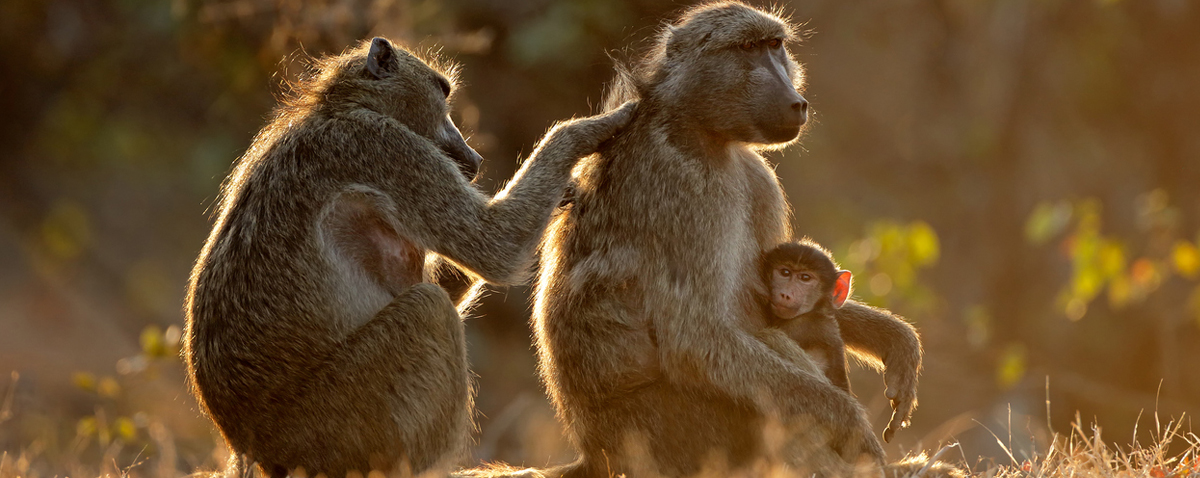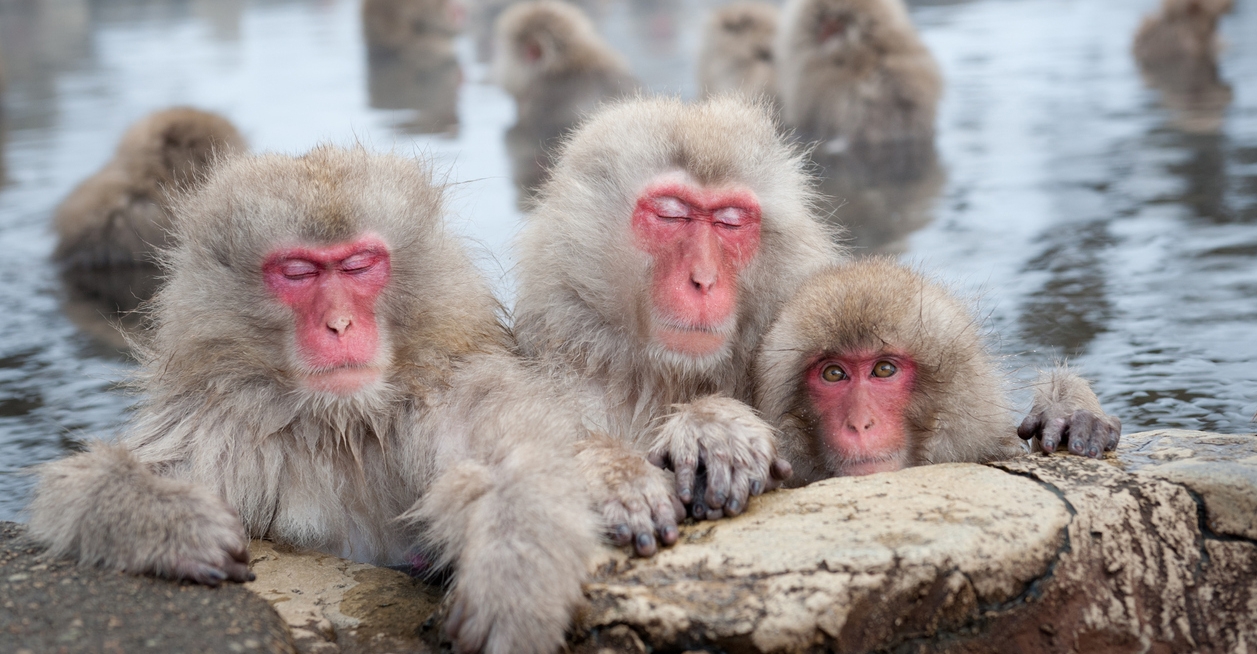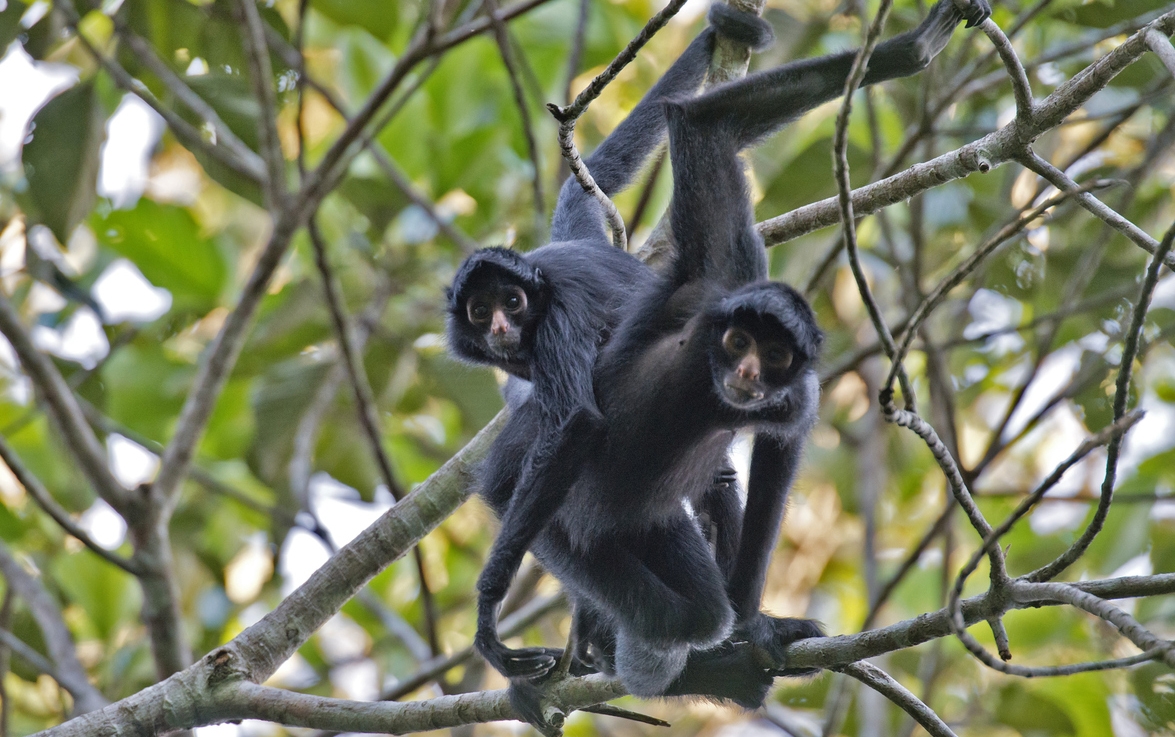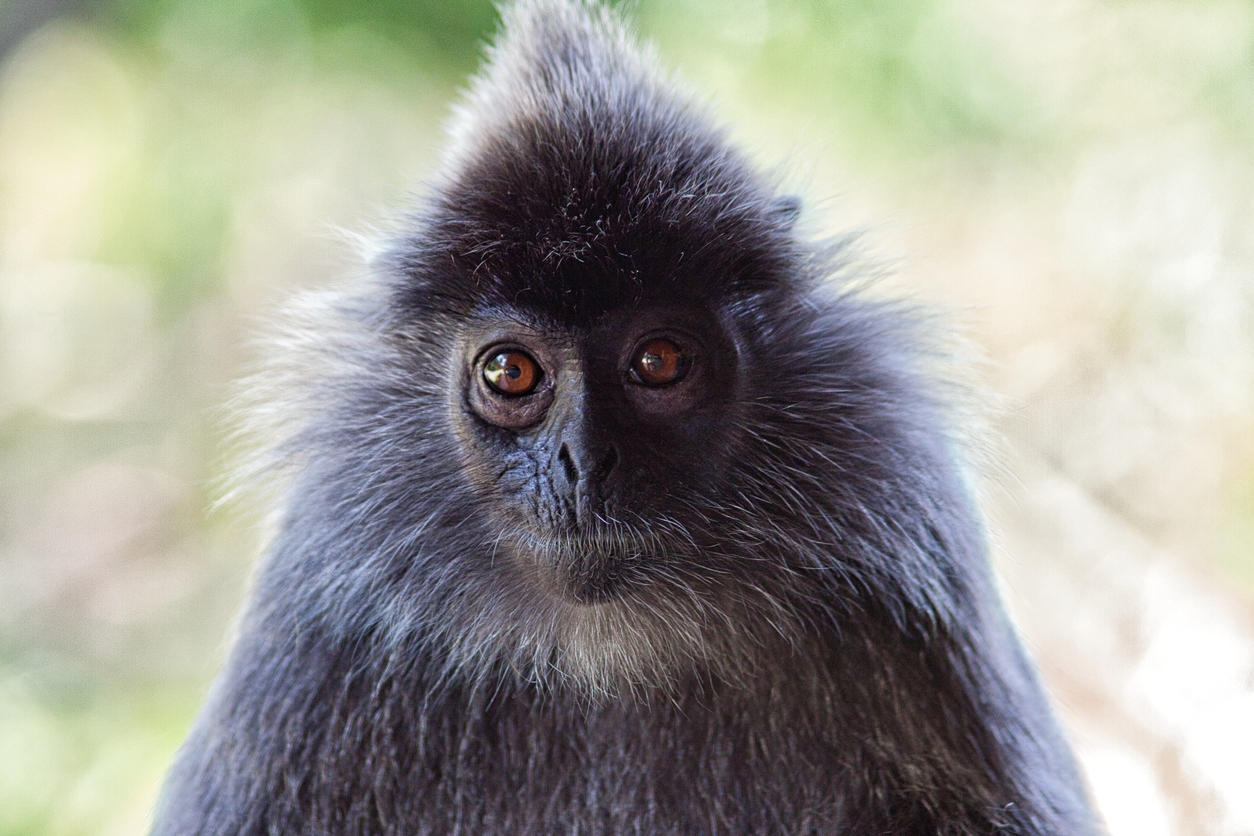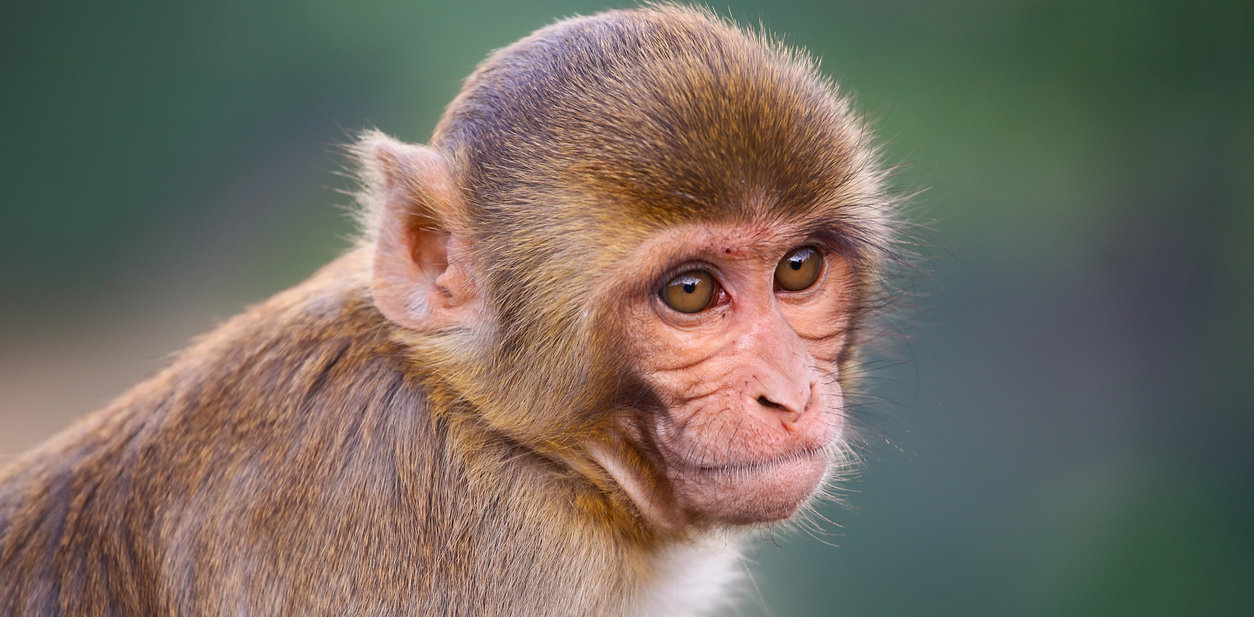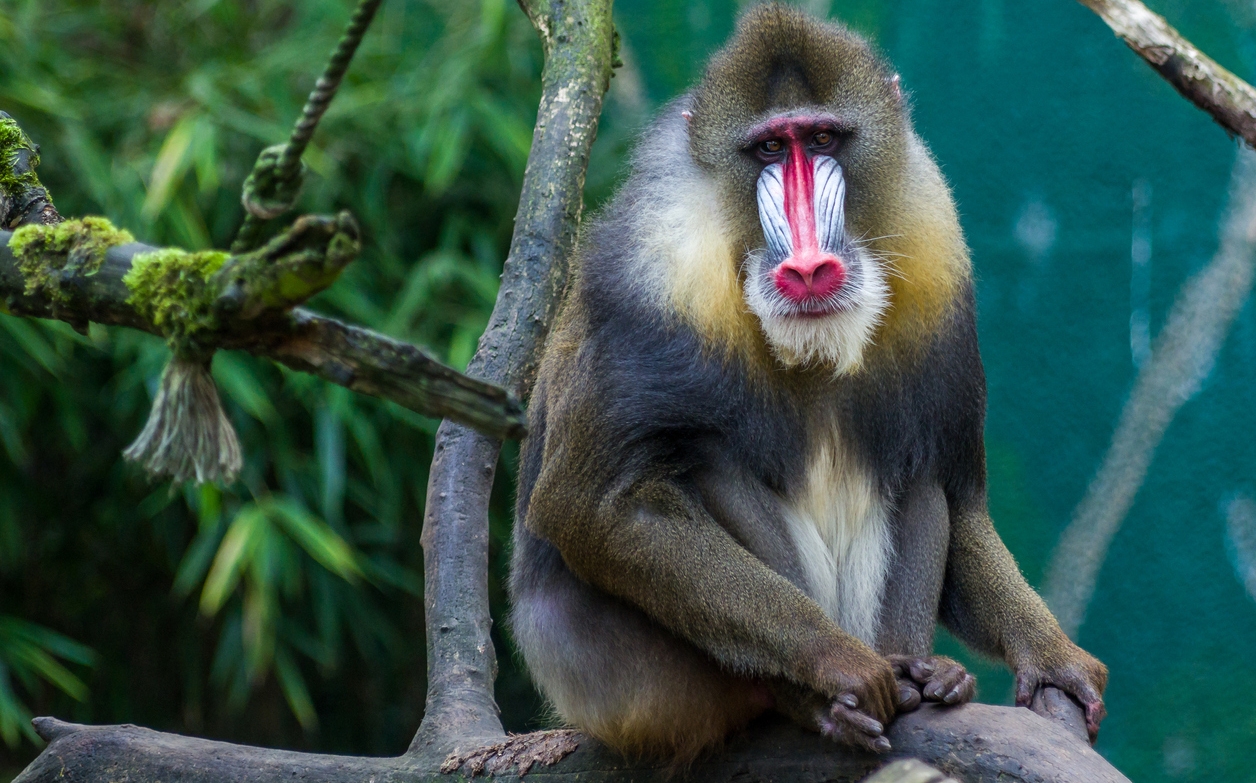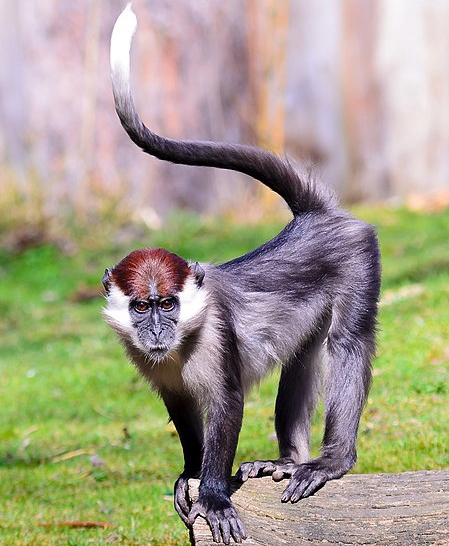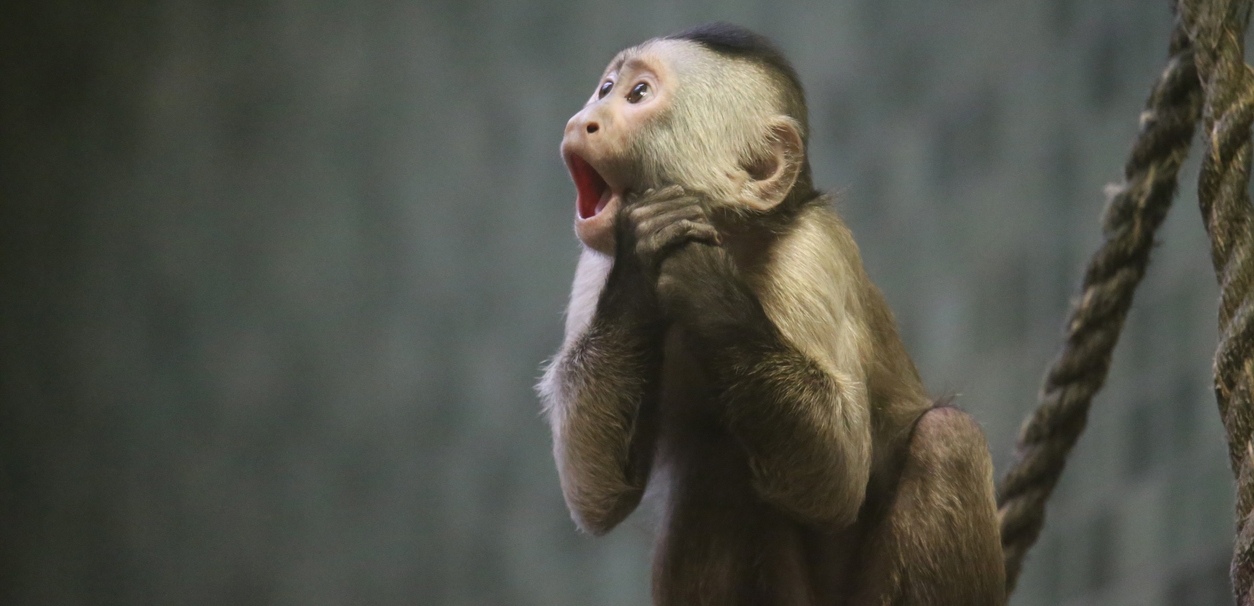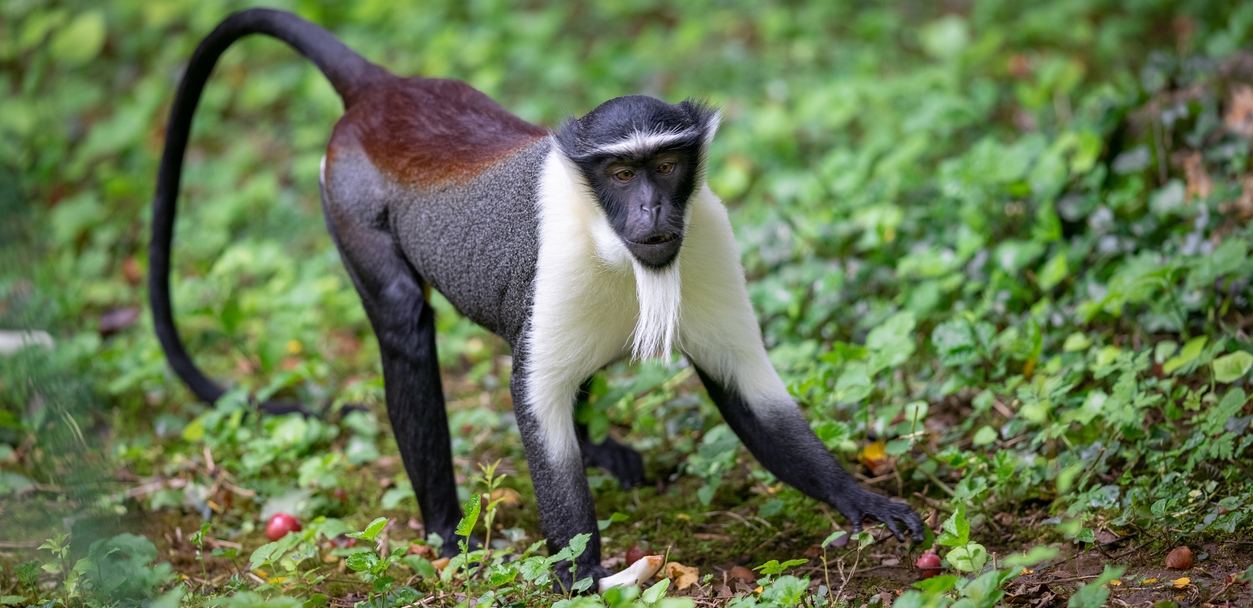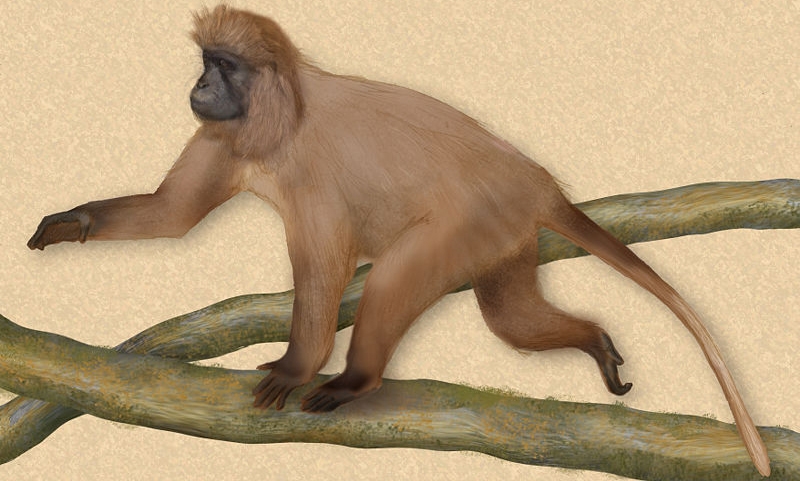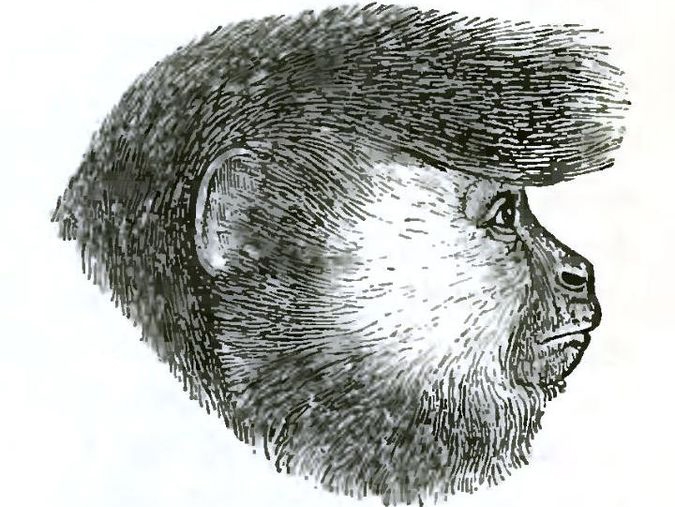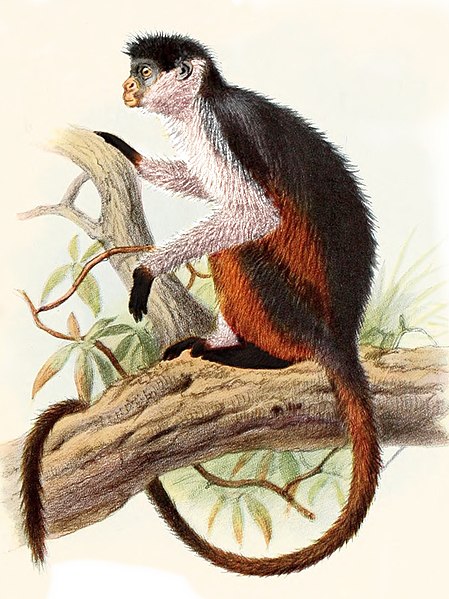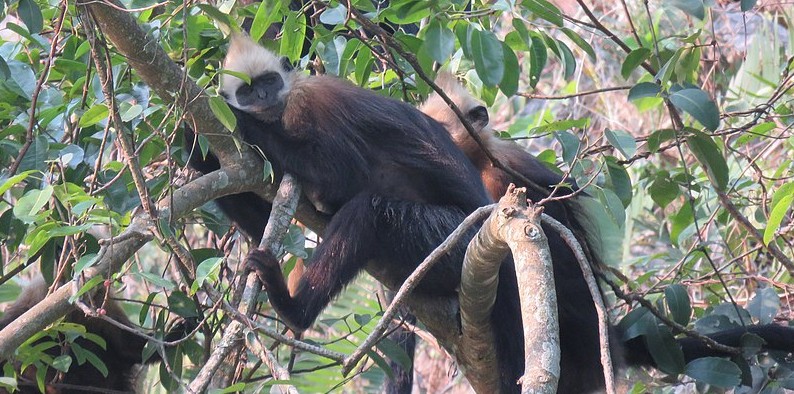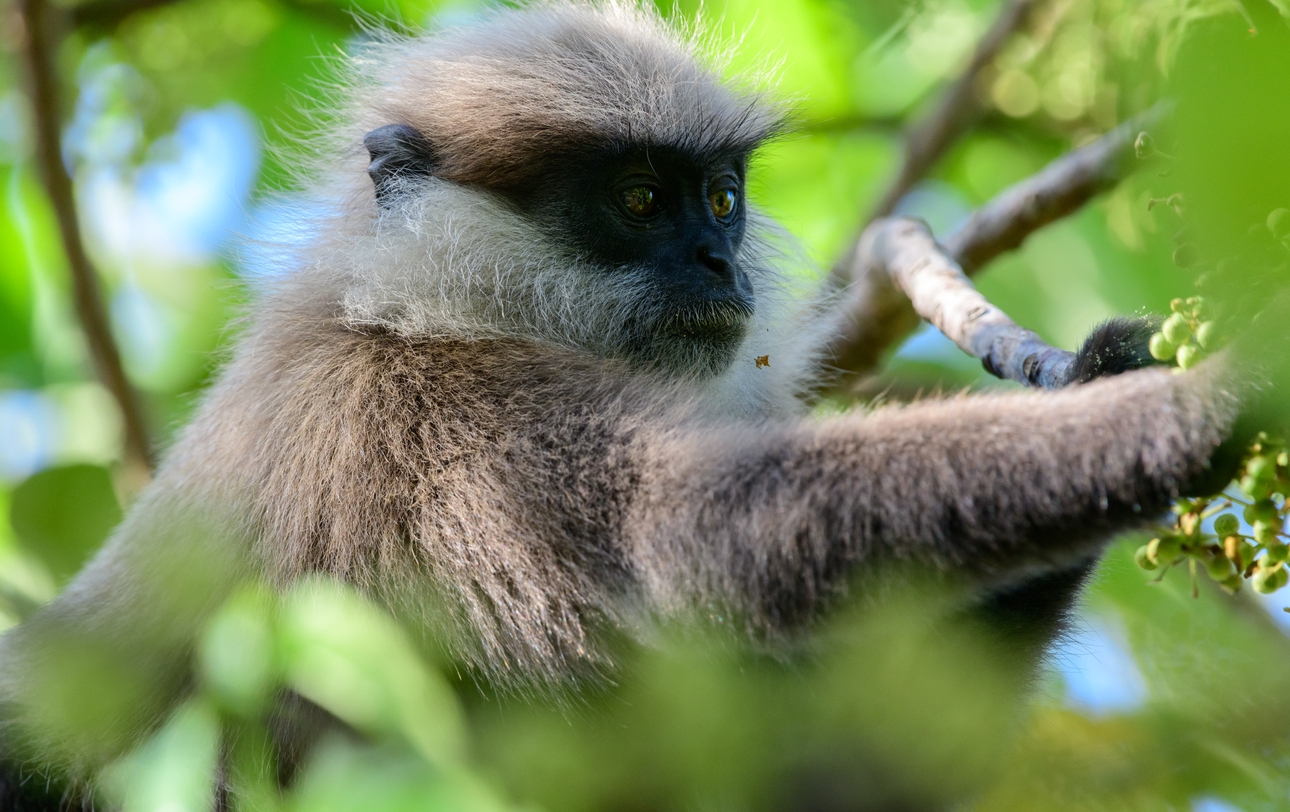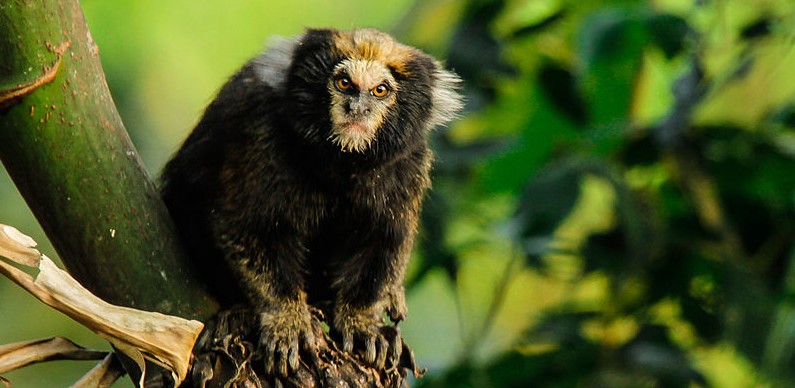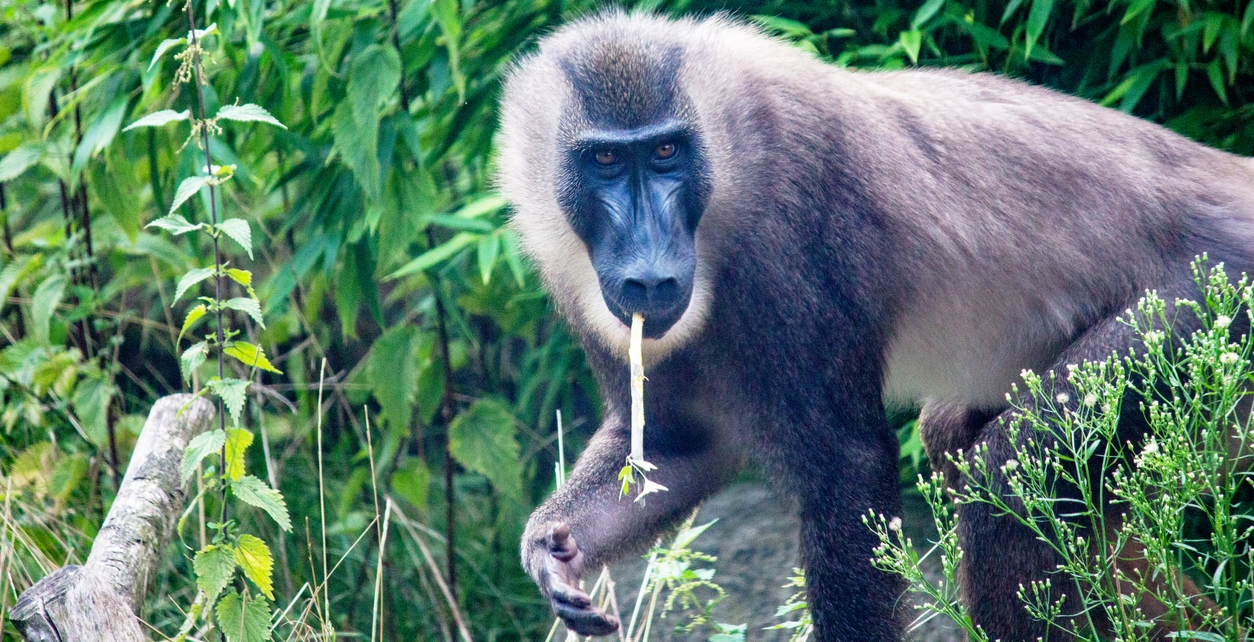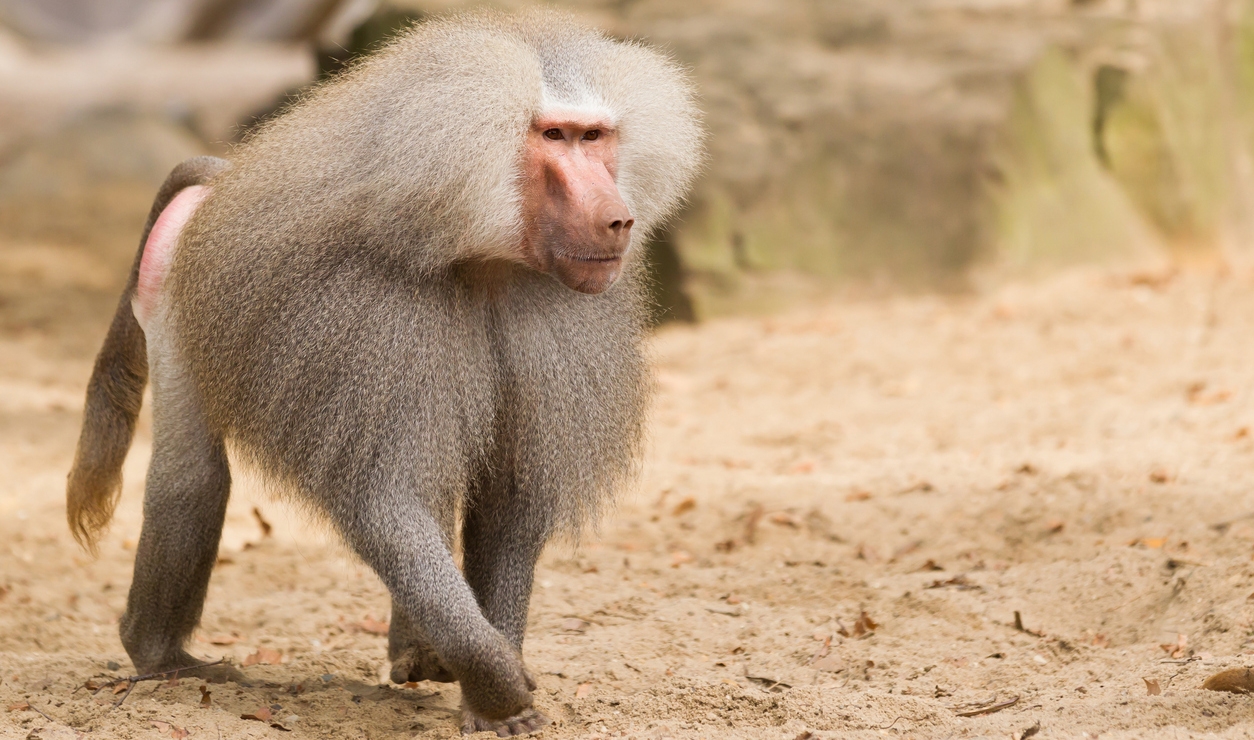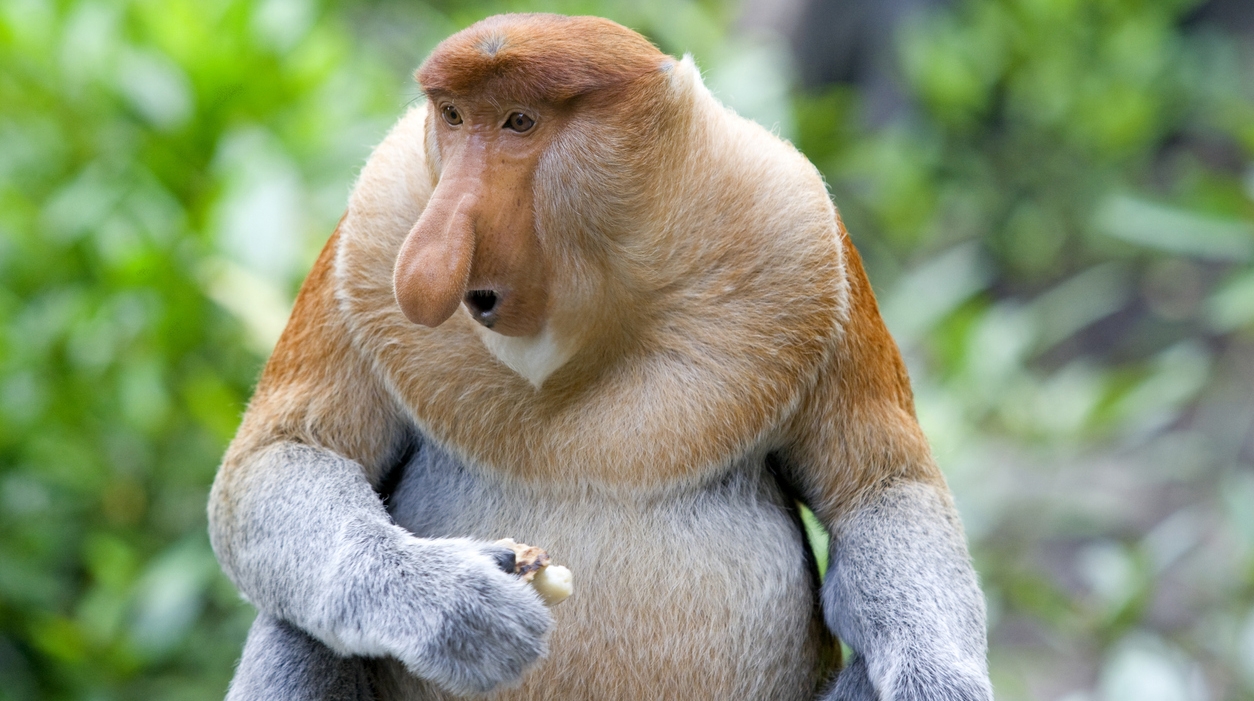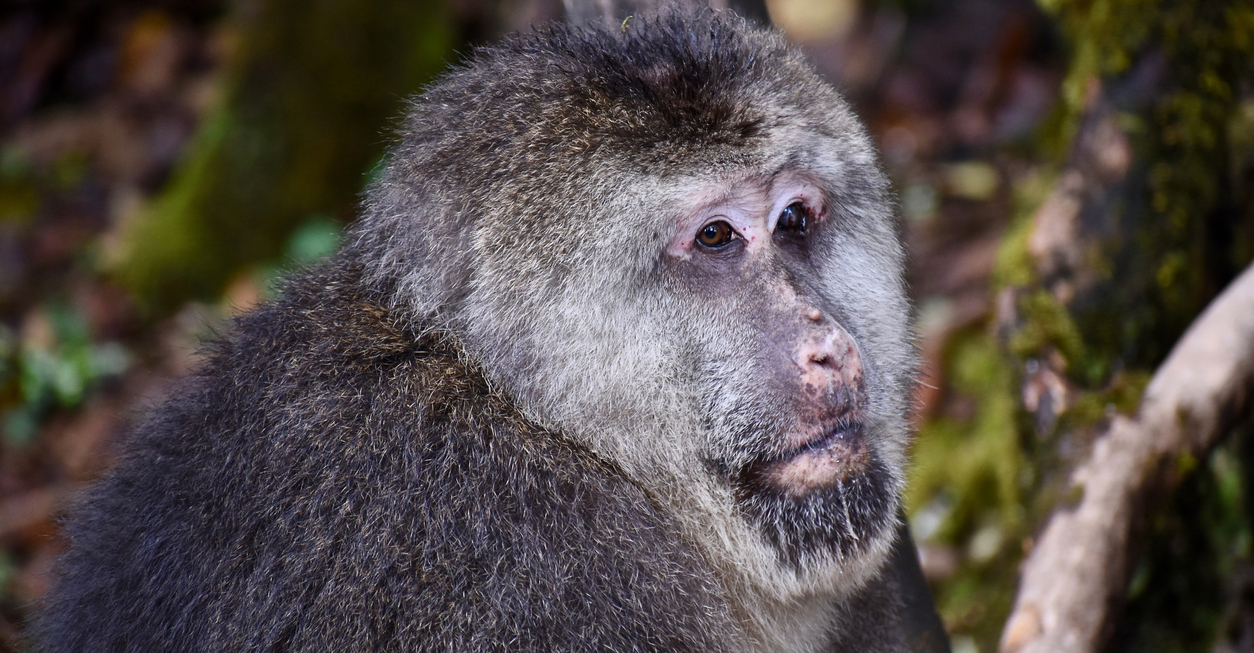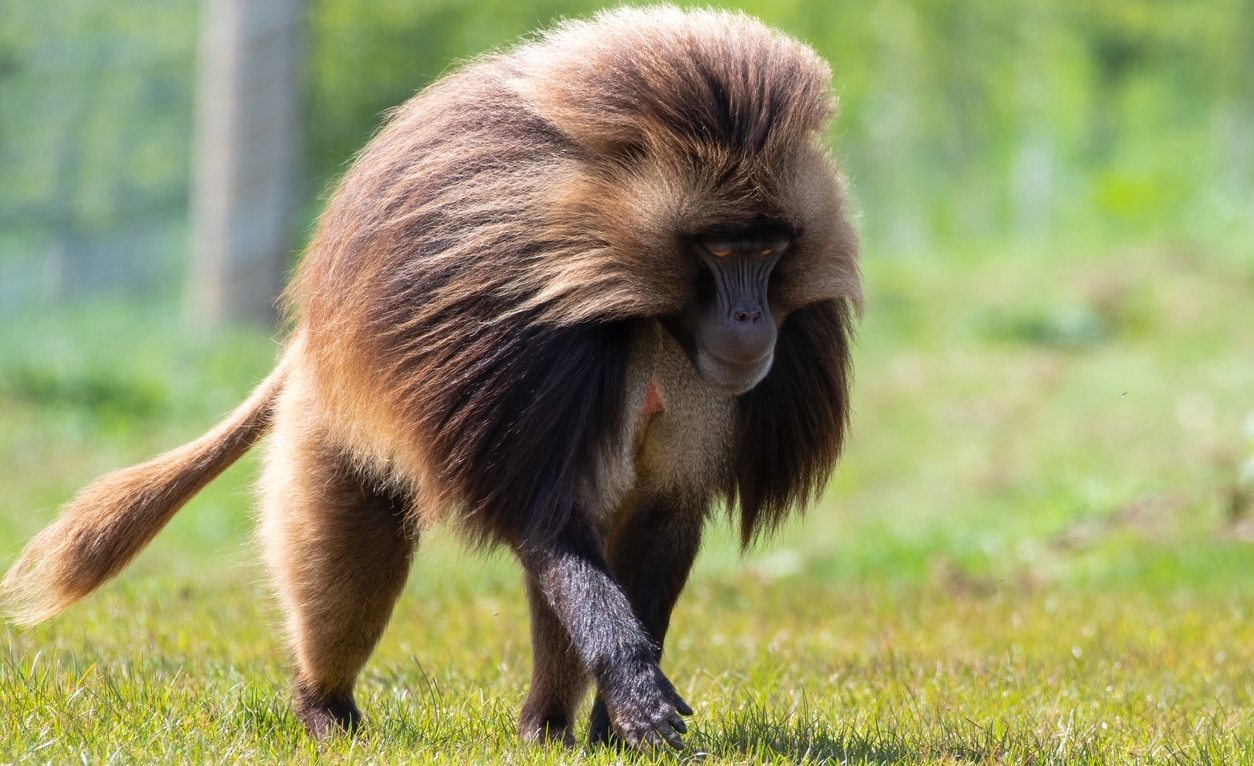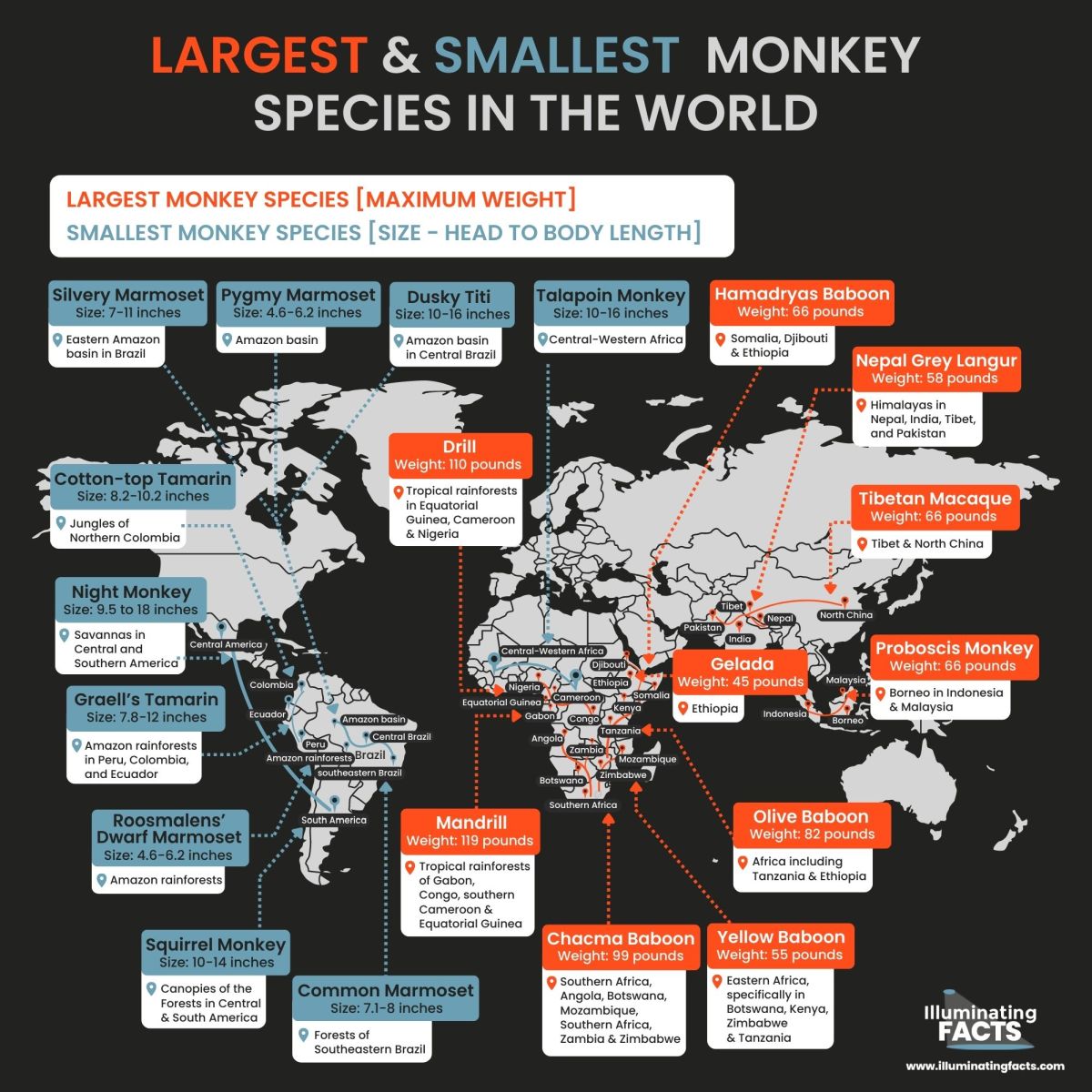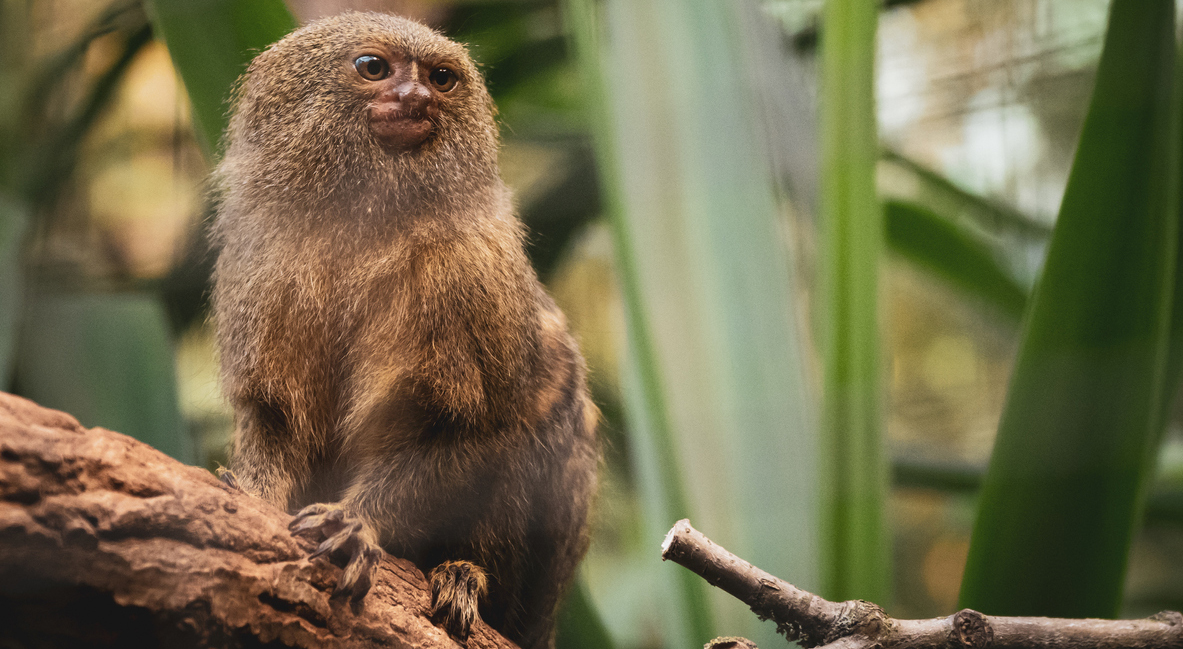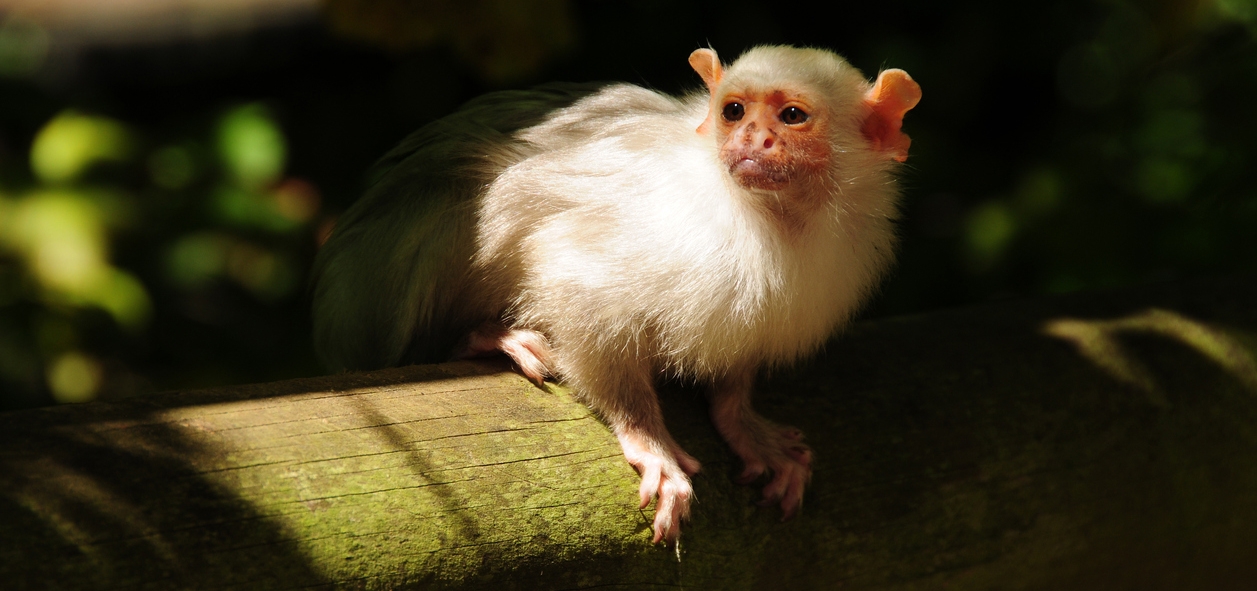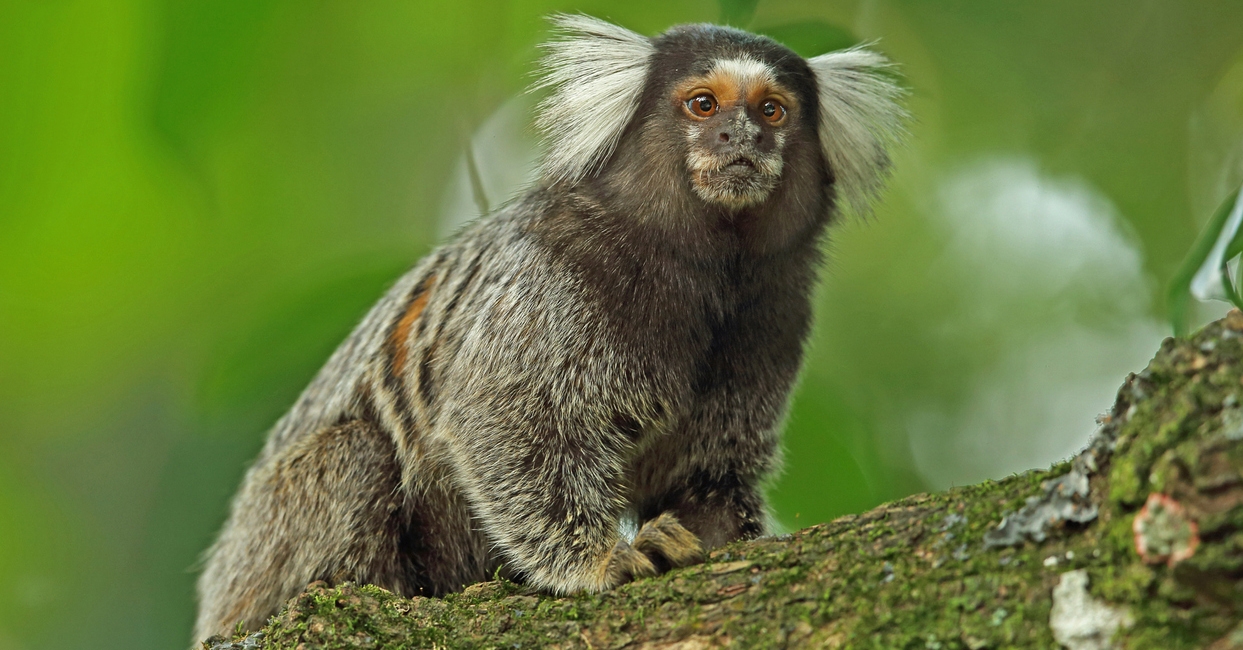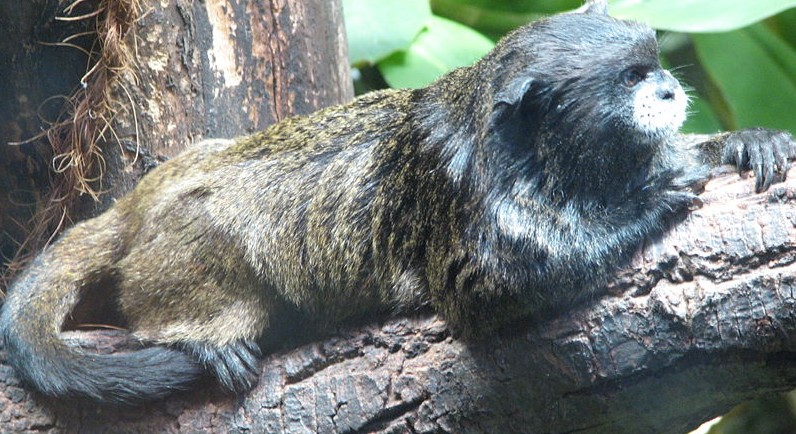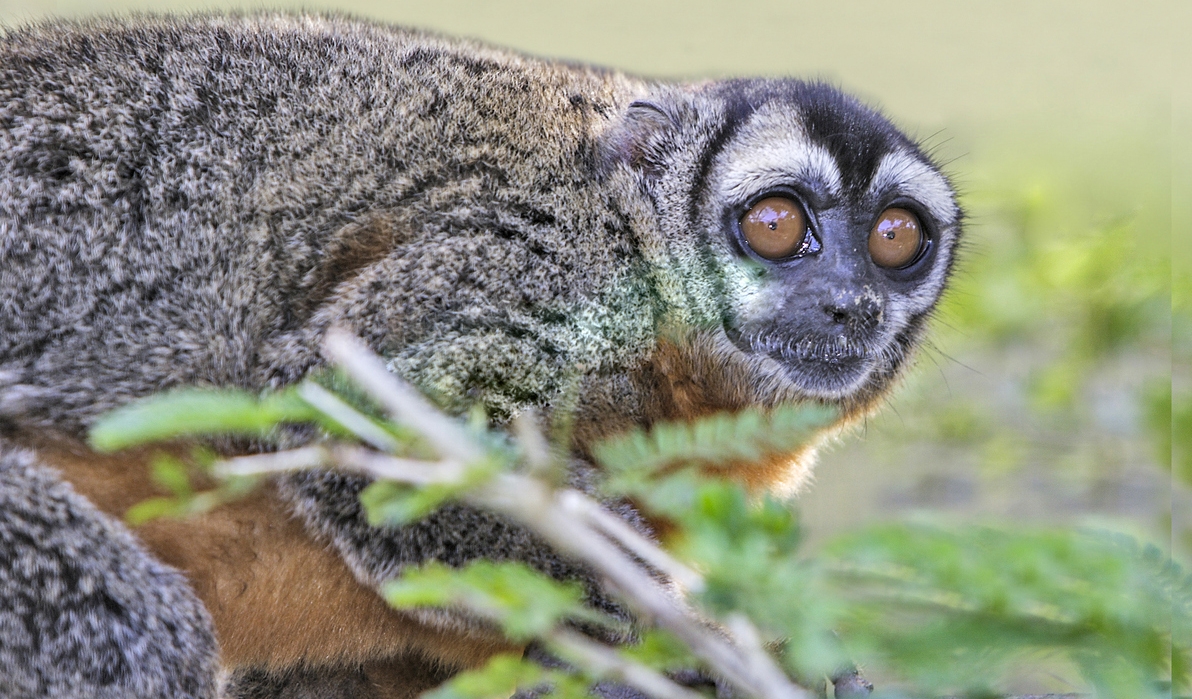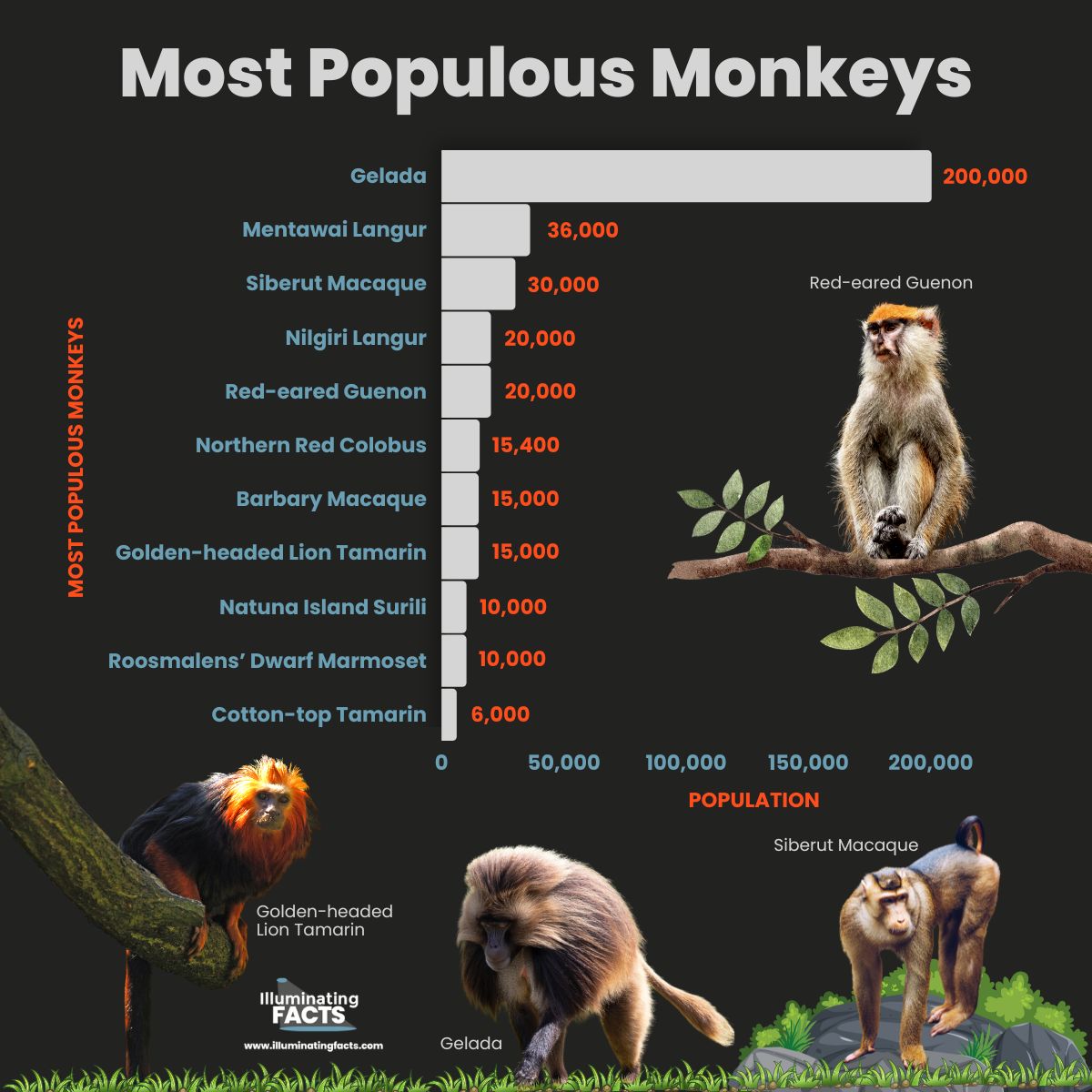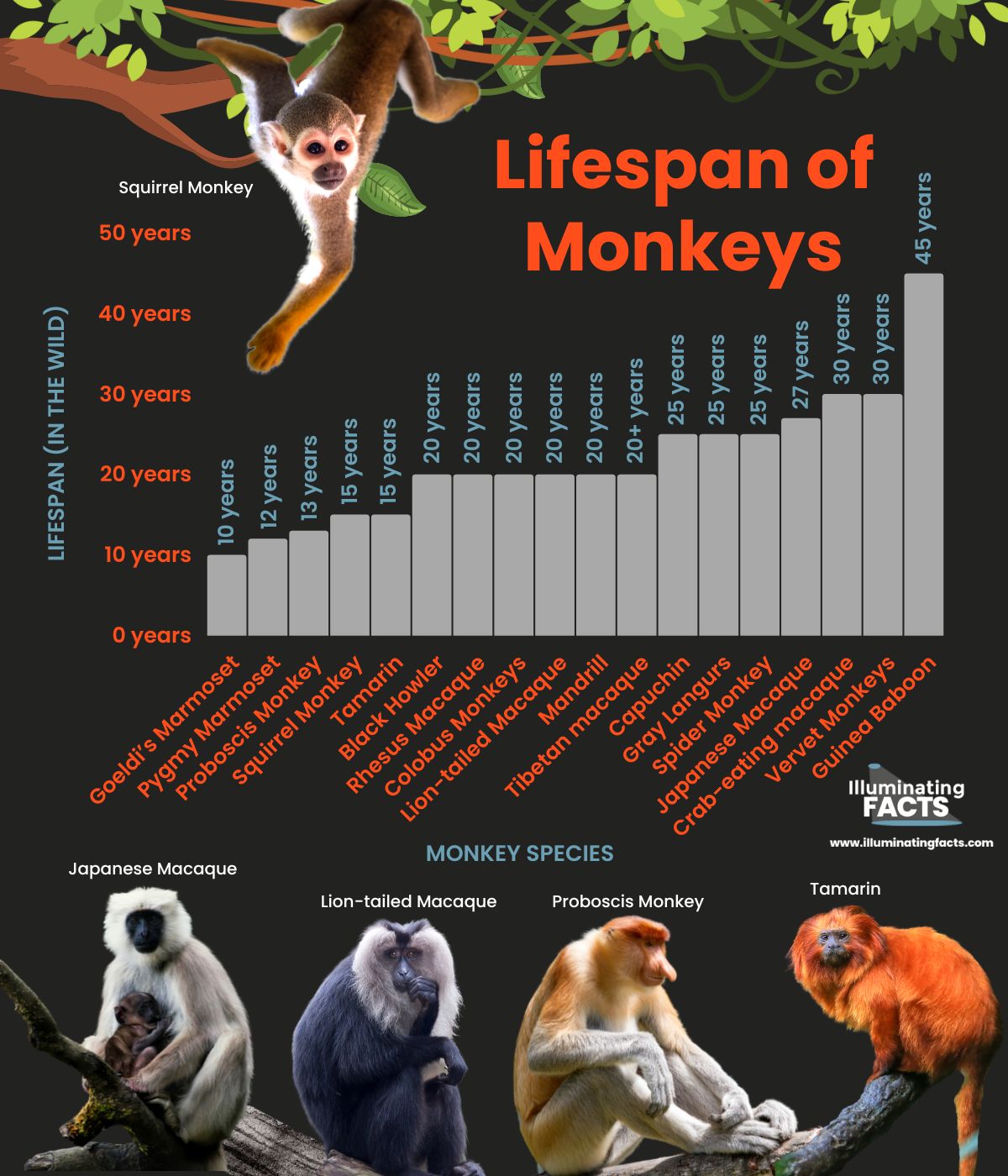Table of Contents
Background
Fascinating, naughty, and often mysterious, monkeys are classified as primates, characterized by relatively larger brains as to their body size and a high degree of intelligence. While they’re commonly known for their loud noises, playful antics, and for “terrorizing” humans and other animals, there’s so much more about our primate cousins that make them interesting to study about and interact with.
If you’re an aspiring primatologist or simply eager to learn more about these remarkable creatures, you’re on the right post as we’ve collated all the necessary information you need right here. This article will cover everything about their habitat, size, smartness, and conservation status.

Golden Langur
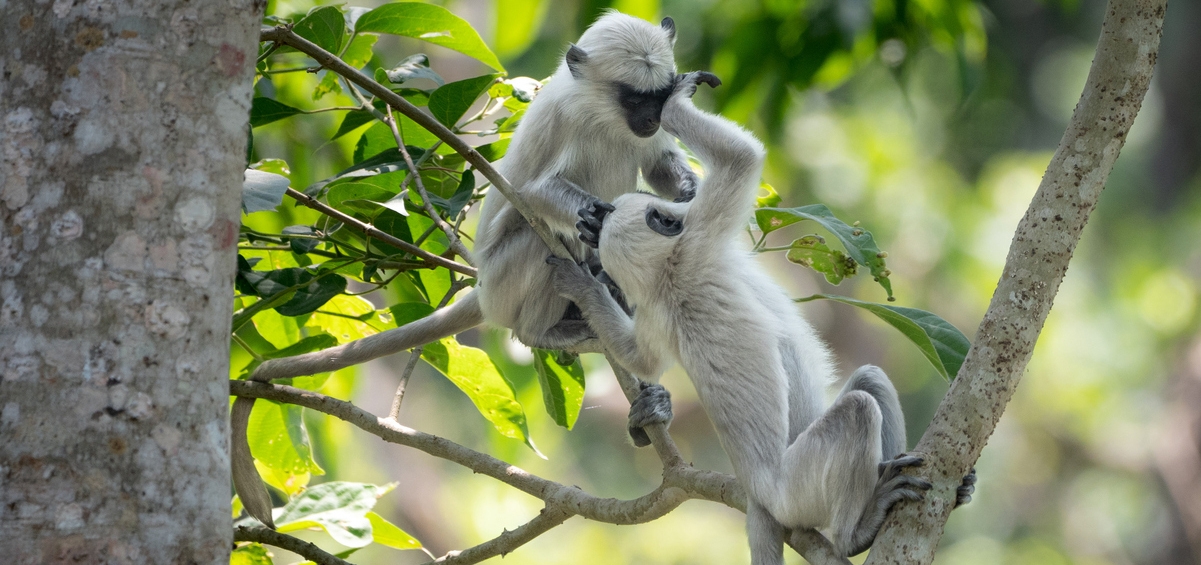
Nepal Grey Langur
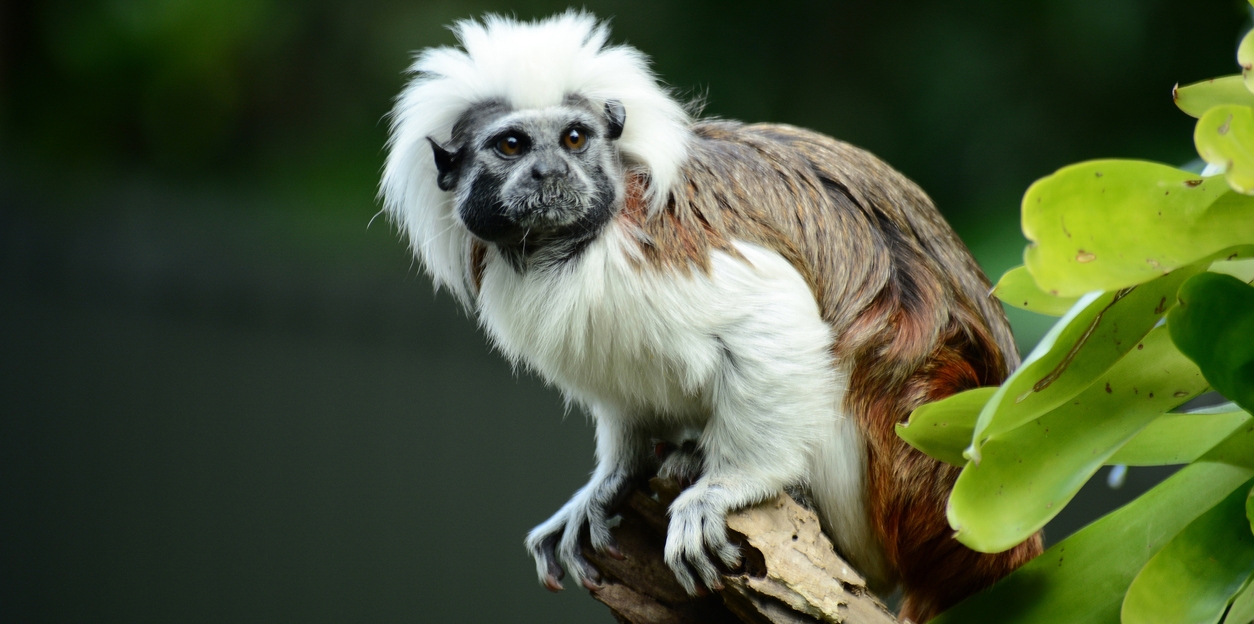
Cotton-top Tamarin

Squirrel Monkey
In addition, we also explore interesting facts you shouldn’t miss about monkeys, all helping you refine your knowledge and understanding of the world’s most spectacular primate species.
Where Do Monkeys Live?
Monkeys generally live in the tropical rainforests of Africa, Central and South America, Asia, and the savannas of Africa. Though all primates live in trees, a few exceptions are the baboons that live on the ground, geladas and golden monkeys that live in the mountains, and the Japanese macaques that live in parts of northern Japan where it snows.
The majority of their habitats lie in tropical to subtropical regions where trees are bountiful, resulting in lots of branches where they can swing and tree tops where they can stay. Other monkey habitats are in the wild, drier or more arid regions, or mountainous areas for those specific monkey types who prefer them.
Meanwhile, the species and features of monkeys also vary on the continent where they live: Africa, Asia, or Latin America. Read on below to discover more. [1]
Monkeys Living in Africa
Monkeys in Africa are found in the tropical and equatorial regions of the continent. A few species thrive in semi-arid and rocky areas of northern and southern Africa. Quite surprisingly some of the monkeys live near human settlements, including towns, villages, and cities.
Most African monkeys also prefer to live in trees at varying heights. Others thrive on the ground or along river and mangrove banks. Among the most common monkey species living in Africa include baboons, drills, mandrills, geladas, guenons, macaques, patas monkeys, and mangabeys. [2]
Monkeys Living in Asia
Asian monkeys thrive primarily in southern Asia, while a few are native to China and Japan. Most of them occupy tropical forests. Some near live human settlements. A few live in the remote, chilly, snowy mountains of northern Asia.
Like African monkeys, Asian monkeys prefer to dwell either primarily on trees, though others also live on the ground and along river and mangrove banks. Some of the common Asian monkeys include snub-nosed monkeys, proboscis, macaques, and leaf monkeys.
Some are active during the day, a few are active at night. Still, such a gap allows the reduction of competition and even distribution of resources, helping these non-human primates thrive. [3]
Monkeys Living in Latin America
Latin American monkeys’ habitat range from parts of southern Mexico up to central South America. They occupy tropical regions, specifically rainforests lying in the equatorial zone. Others live in the cloud or montane rainforests that are higher in elevation and relatively cooler. They dwell on the ground, along river and mangrove banks, but mostly on trees.
Like monkeys in the other two continents where they are native, Latin American monkeys can also be found living in areas where humans populate. Most monkey species are diurnal or active in the day, while a few can be classified as nocturnal. [1] [4]
Major Groups of Monkeys
Monkeys can be categorized into two major types: Old World monkeys and New World monkeys. Old World monkeys primarily live in Africa and Asia, while the New World monkeys thrive in Central America to South America. It is generally believed that the split happened about 40 million years ago through natural evolution.
1. Old World Monkeys
Old World monkeys are found in all of Africa except for the deserts, on the Arabian Red Sea coast, and in Asia, starting from Afghanistan to Japan. Their range continues southeast, specifically in the Philippine, Bacan, Celebes, and Timor islands. A few Old World monkeys have already been successfully introduced in parts of Europe like France, Belau, Mauritius, Gibraltar, and some islands in the West Indies.
One of the key physical characteristics that separate Old World monkeys from their New World counterparts is their nostrils which are closer together and face downward. Most of the Old World monkeys have tails. If one is present, it can be short or long but it isn’t prehensile or lacks the ability to grasp or hold objects. Many of these monkeys have ischial callosities or thick, hard, and bare sitting pads on the buttocks.
Two subfamilies of Old World monkeys exist: Cercopithecines and Colobines. Cercopithecines have cheek pouches, which extend down to the neck and serve as storage for food. Such pouches are very useful, especially if predators arrive while they are foraging for food on the ground. Some of the monkey species that fall under this subfamily include baboons, macaques, and guenons.
Meanwhile, colobines don’t have cheek pouches but these leaf-eating monkeys have complicated sacculated stomachs. It has three to four chambers or compartments containing bacteria and A certain blend of enzymes that digest plant cellulose, converting them into usable calories and enriching the nutritional content of their special diet. Langurs, proboscis monkeys, and colobus monkeys are part of this subfamily.
Other Old World monkey species include talapoins, doucs, vervet monkeys, gelada, mangabey, mandrill, and surilis. They are omnivores and their diet consists of plants, fruits, small animals, insects, and handouts from humans.
Old World monkeys are often referred to as true monkeys, given their closer resemblance to apes and humans than to the monkeys of the New World. With that, it’s inferred that these two monkey groups have descended separately from ancestral primates. [5] [6] [7] [8]
2. New World Monkeys
New World monkeys are primarily found from South Mexico up stretching until central South America, especially in the Amazon rainforests, the exception is the high mountains. Contrary to their Old World counterparts, New World monkeys are flat-nosed with nostrils separating outwardly and facing the sides. They also lack the ischial callosities and cheek pouches present in Old World monkeys.
Meanwhile, most New World monkeys have prehensile tails, which means they can use their tail to support their entire body weight and hang from branches, or grasp objects, such as their favorite food. However, they lack the opposable thumbs that allow Old World Monkeys to handle small objects precisely. In fact, the thumbs of New World monkeys are either reduced or absent, with the primary activities done using the index and middle fingers.
New World Monkeys also have 36 teeth, compared to the Old World monkeys only 32. Their gestation period is only four to five months, relatively shorter than the five to nine-month gestation period of the Old World Monkeys. In general, New World Monkeys are also relatively smaller compared to the opposite group. In terms of diet, New World monkeys are also omnivores, eating fruits, flowers, nuts, insects, and small mammals.
Five New World monkey families exist: Callitrichidae, Cebidae, Pitheciidae, Atelidae, and Aotidae. The Callitrichidae family includes tamarins and marmosets, while the Cebidae family includes squirrel monkeys and capuchins. On the other hand, the Pitheciidae family includes the unique monkey species: the sakis, uakaris, and titis. The Atelidae family covers some of the largest New World monkeys, the spider, howler, woolly spider, and woolly monkeys. The Aotidae family completes the list of families, but it only has one genus: the douroucoulis or the night monkeys.
As the ecological niches where Old World and New World monkeys are the same, there are some noticeable parallels between the two groups. For instance, the talapoin found in West-Central Africa and the squirrel monkeys have spectacular convergence, with both only weighing around 2.2 pounds (1 kilogram), thriving in big troops along rivers, and breeding seasonally. Still, there are big differences, such as the spider monkeys’ complex social structure and community, which do not exist in Old World monkeys, but are rather comparable to the chimpanzees. [5] [6] [7] [8]
Old World Monkey vs. New World Monkey Comparison Table
Old World Monkeys |
New World Monkeys |
| Found in Afica and Asia. | Found in Central and South America. |
| Have closer nostrils that face downward. | Have flat nose with nostrils facing the sides. |
| Cheek pouches are present. | Cheek pouches are absent. |
| Have non-prehensile tails. | Have prehensile tails. |
| Have thick, bare, hard sittings pads. | Lack the ischial callosities. |
| Have 32 teeth. | Have 36 teeth. |
Smartest Monkeys
Monkeys are among the smartest animals in the world. They have large brains and are renowned for their innate curiosity and intelligence, giving them sophisticated abilities to apply knowledge, learn from experience, and perform a considerable array of activities.
What’s even great is that they pass information from one generation to another, with the young ones learning from their families about grasping new objects, solving problems, using tools, finding food, communicating with others, and understanding their society.
With that, it’s no surprise that their smartness has long fascinated us, humans. Though it doesn’t match our level of intelligence, it’s enough for us to often see ourselves in them and in their actions.
Here, below are some of the smartest creatures in the monkey world based on the hierarchy of primate intelligence. [9] [10] [11] [12]
1. Spider Monkeys
In the research conducted in 2006 analyzing the intelligence of extant primates, humans ranked first, followed by the orangutans and chimpanzees who got second and third place, respectively. Coming in fourth place are the spider monkeys, making them the third-smartest among non-human primates and the most intelligent among New World monkeys.
Spider monkeys are famous for their remarkably long, skinny, graceful limbs and strong, prehensile tails. They look like spiders when hanging upside down on tree branches using their tails while their long arms and legs are dangling.
These New World monkeys have incredibly good memories and complex social behaviors that mark their incredible intelligence. They are often seen hugging and wrapping their tails with one another. As an attestation to their smartness, a type of global computer algorithm, the SMO (Spider Monkey Optimization), was inspired by them. [13] [14]
2. Surilis
Next on the list is the Surilis, a group of Old World monkeys hailing from the genus Presbytis. These intelligent monkeys thrive on Sumatra, Java, Borneo, smaller nearby islands, and the Thai-Malay Peninsula. Other common names used to refer to them include “leaf monkey” or “langur.”
They are small, slimly-built monkeys, who live in troops of up to 21 individuals, composed of a male, a few females, and their offspring. All-male groups and lone males have also been recorded. Their troops follow hierarchy with communication in the group happening both in vocal and postural manners.
Surilis are diurnal forest dwellers, spending almost their entire lifetime in the trees. Their diet consists of fruits, seeds, and leaves. Unfortunately, their numbers are threatened by habitat destruction and hunting with several of the surili species classified by IUCN (International Union for Conservation of Nature) as vulnerable or worse, making them one of the smartest primates but also among the rarest and most endangered. [15] [16]
3. Macaques
The third monkey in the hierarchy of primate intelligence is the macaque. Macaques are Old World monkeys that consist of more than 20 species. All of them live in Asia, except for the Barbary macaque that dwells in North Africa.
Clever, social, and intelligent, these monkeys are renowned to have enhanced general smartness compared to other mammals and are capable of using tools and displaying other innovative behaviors. For example, they wash their food in the water, utilize stones to open up shells and nuts, or steal food from people and barter it for treats.
Boasting the greatest geographical distribution, macaques are also the world’s most common non-human primates. Though naturally charismatic, they have very complex behaviors and social structures, with females having strong and long-lasting hierarchies, while males have shifting dominance.
Communication occurs in numerous ways, including strong glares, loud barks, screeches, coos, whimpers, grunts, slapping of the ground, lunging, and branch shaking, further showing their incredibly interesting behavior.
Macaques are primarily arboreal, but can also stay on the ground. Habitats vary depending on the species and they can live in forests, rocky terrains, cliffs, or plains. Some have learned to live near or around human settlements, leading to more frequent interactions.
Due to their resemblance to humans, macaques have also been a popular research animal. For instance, crab-eating macaques have played crucial roles in cloning technology and the polio vaccine, while the rhesus macaques have served key parts in the creation of polio, smallpox, and HIV treatments. [17] [18] [19]
4. Mandrills
Mandrills are part of the elite club of the smartest non-human primates. Like other intelligent primates, they are known to use tools in performing tasks, with one even filmed in the UK stripping a twig and utilizing it in cleaning its toenails.
Meanwhile, they are also capable of developing new gestures for communication. A female mandrill, also in the UK, was studied and discovered that covering her face with her hands meant “to leave her alone”. Eventually, younger mandrills have also learned and mimicked the gesture, proving their high level of intelligence.
Mandrills are shy and isolated monkeys that are only found in the rainforests of equatorial Africa. They also live in troops led by a dominant male, a dozen of females, and their young. Some gather in multi-male and multi-female troops that can include up to 200 individuals.
These large monkeys are primarily terrestrial and use their long arms to search for food like fruits, roots, insects, reptiles, and other small animals on the ground. While they spend most of their time on the ground, mandrills climb trees for sleeping. [20] [21] [22]
5. Guenons
Guenons are medium-sized Old World monkeys that are renowned for beautiful patterns, such as brown bands, nose spots or bands, and hip stripes. Their face also features other striking adornments like a mustache, beard, or a throat ruff. They live in large troops and are also known to be one of the most graceful and lively animals living in Africa. Apart from their conspicuous appearance, guenons are also remarkably smart, ranking ninth among the most intelligent primates, and fifth among monkeys. [23] [24] [25] [26]
6. Mangabeys
Mangabeys are Old World monkeys that dwell in the African tropical forests. They have slender, long limbs and resemble the guenons but are relatively larger in size. Mangabeys are highly intelligent and social primates. They have interesting ways of communication, given that it’s quite challenging for them to see one another in the thick forest canopy.
Mangabeys tend to be very noisy and produce a booming voice powered by their special throat sacs. This sac is larger in males, and they can make shrieking vocalizations in the form of barks, grunts, and twitters to alert others of danger. In terms of diet, they primarily eat leaves, fruits, and seeds. Thanks to their large front teeth, they’re able to bite tough-coated fruits that other monkeys can’t handle. [27] [28] [29]
7. Capuchin
Capuchins have a high level of intelligence and inquisitiveness and are deemed as one of the smartest among New World monkeys. They got their name from the easily recognizable hair cap that looks similar to the cowls of the Capuchin monks. Also called sapajou, they are common in Central and South America, thriving in the tropical forests of Nicaragua to Paraguay.
In one study at Yale University, researchers were able to introduce the concept of money to captured brown capuchins. They provided the creatures with metal disks that acted like coins and the brown capuchins were able to learn how to exchange and budget their coins to buy cheap and expensive items like grapes and Jell-O.
Later on, it was observed that the monkeys also used coins to exchange sex with other monkeys, attesting that they fully grasp the value of money to goods and services.
Meanwhile, if you have seen a monkey in a movie or on television wearing a hat-and-vest and collecting money from street shows – it’s most likely a capuchin. [30] [31] [32]
Endangered Monkeys
A primate planet, Earth is home to 8 billion humans who occupy and have transformed it in endless ways. Despite such, not all primates experienced the same success, with many of them at risk of facing oblivion. Illegal wildlife trade, hunting, and a wide range of habitat destruction put many monkeys in great peril of being extinct. Without conservation efforts, they can be soon wiped out completely from the surface of the Earth.
Here’s a list of some of the globe’s most endangered monkeys based on the IUCN Primates in Peril report. [33]
1. Roloway Monkey
Endemic to the tropical forests of Ghana and Ivory Coast, Roloway monkeys (Cercopithecus roloway) are Old World monkeys that are easily distinguishable through their long, distinctive beard and mainly black overall fur with white areas. These tree dwellers prefer undisturbed, mature forests across their range. However, some parts of their former locations no longer have any roloway monkeys present.
Based on the report, only less than 2,000 individuals exist. Their demise is caused by habitat degradation due to illegal logging and the crop industry. Moreover, they also suffer from the bushmeat trade with the majority of the rural people in Ghana depending on bushmeat as the primary protein source. Their number continues to decrease year by year as these creatures aren’t also adept at quickly adjusting to the changes in their surroundings. [33] [34] [35]
2. Kipunji
Only discovered in 2003, Kipunjis (Rungwecebus kipunji), also known as highland mangabeys, live exclusively in Tanzania. Only two populations exist, one in the Ndundulu Forest and the other in Rungwe-Livingstone Forest. Kipunjis are a social species that build troops composed of up to 36 individuals. They are renowned for their loud, deep “honk-bark” and distinctive chirping vocalizations.
While there has been considerable success in restoring their natural habitat, kipunjis’ numbers are still under grave threat with only over 1,100 individuals existing in 38 groups. Today, kipunjis are among the flagship animals for the conservation efforts in the area. [33] [36] [37]
3. White-Thighed Colobus
White-thighed colobuses (Colobus vellerosus) are stunning monkeys once abundant in the forests of Ghana, Togo, Benin, Nigeria, and Ivory Coast. Also known as ursine colobus monkeys and Geoffroy’s black-and-white colobus monkeys, they occupy swamp forests, gallery forests, the upper canopy of lowland forests, semi-deciduous forests, and savanna-woodlands.
Today, their current population is only estimated to be less than 1,200. They’re classified as critically endangered and they are on the edge of extinction due to forest loss and intensive hunting for bushmeat. Previously thriving in Burkina Faso, the white-thighed colobuses have already been extirpated in the country and are only hanging and almost gone in two other countries. [33] [38] [39] [40]
4. Niger Delta Red Colobus
Niger Delta red colobuses (Piliocolobus epieni) were only discovered in 1993 and were once deemed to be a subspecies of the western red colobus before they were declared as a full species in 2007. These monkeys are native to southern Nigeria and previously thrive in land stretching 1500 square kilometers (580 square miles).
Worsened habitat destruction and hunting took a massive toll on their number. They can now only be found in fragmented habitats in a 200-square-kilometer (77-square-mile) patch of land situated south of the original range. The Niger Delta red colobuses are in an imminent threat of extinction as only 500 individuals remain. [33] [41] [42] [43]
5. Tana River Red Colobus
Tana River red colobuses (Piliocolobus rufomitratus) are small primates with red or dark red fur thriving in northern Kenya’s Tana River. They occupy a small range of fragmented forests stretching to only 60 kilometers (37 miles). The rapid increase in human population, hunting, forest clearance, and dam construction (which caused changes in vegetation affecting their food source) led to the detrimental decline of their populations. IUCN classifies the species as critically endangered, with only less than 1,000 individuals remaining. [33] [44] [45] [46]
6. Pig-Tailed Snub-Nosed Langur
Pig-tailed snub-nosed langurs (Simias concolor) are monkeys found solely in the Mentawai Islands situated off the western coast of Sumatra, Indonesia. They live primarily in trees, only going down to the ground when disturbed. They are observed in small social groups, composed of 3-8 monkeys. Leaves, fruits, and berries mostly compose their diet.
These monkeys are now on the brink of extinction as they are hunted for their meat which is considered a delicacy. Habitat loss due to extensive logging added to the decline in their numbers. As a result, it is estimated that only 3,200 individuals remain. [33] [47] [48] [49] [50]
7. Cat Ba Langur
The Cat Ba langurs (Trachypithecus poliocephalus), also referred to as the golden-headed langur, are native to Cat Ba Island, the largest island among the 367 islands in the Cat Ba Archipelago in northeastern Vietnam. The beautiful island is home to a wide array of natural ecosystems, namely mangrove forests, willow swamp forests, coral terraces, limestone boulders, and beaches. As such, it also hosts more than 1,500 unique species of flora and fauna.
Though abundant in the area, Cat Ba langurs were hunted for traditional medicinal purposes, causing their number to rigorously decline. While conservation efforts caused significant strides in their numbers, these monkeys remain critically endangered, with only 65-67 individuals left. Their range is restricted to only less than 20 square kilometers (8 square miles) of moist tropical forests found inside the Cat Ba National Park. [33] [51]
8. Golden Langur
First discovered in 1953, golden langurs (Trachypithecus geei) are primates native to Assam, India, and Bhutan. They got their name from their distinctive golden-orange fur, which only shows during the breeding season. Throughout the year, their fur is either cream or dirty white. These monkeys are in great trouble as they are currently listed as critically endangered on the IUCN Red List. Major threats to their number include road accidents, dog attacks, power lines, and loss of habitat due to deforestation. It is estimated that only 7,000 individuals are remaining in the wild. [33] [52] [53]
9. Purple-Faced Langur
Purple-faced langurs (Semnopithecus vetulus) are long-tailed arboreal monkeys native to Sri Lanka. They are distinguishable by their mostly brown fur, dark upper face with pale lower face, and timid demeanor. They are herbivores, feeding primarily on leaves but also eating seeds, flowers, and fruits.
No data is provided by IUCN and other sources on the current population of these monkeys, but they are classified as Endangered. Major threats to their number include rapid habitat loss due to deforestation, urbanization, and road production, poisoning from farmers, road accidents, hunting for medicine and food, and attacks from domesticated animals. [33] [54] [55]
10. Buffy-Tufted-Ear Marmoset
Buffy-tufted-ear marmosets (Callithrix aurita), also called white-eared marmosets or the buffy tufted-ear marmosets, are New World monkeys that can be found in the forests of coastal southeast Brazil. It has the southernmost range among all the species of marmosets. Unlike their cousins, their facial structure prevents them from stripping bark to get sap and gum from trees. Instead, insects primarily compose their diet.
Yellow fever outbreak, ever-shrinking habitat, and invasive marmoset species decimated the population of buffy-tufted-ear marmosets. They are considered a critically endangered species with less than 1,000 individuals left in the wild. [56] [57]
Largest Monkeys
Monkeys around the world also come in all sizes. While they aren’t larger compared to their great ape cousins, such as the gorillas, chimpanzees, and orangutans, some monkeys boast considerable size, further proving how incredible these animals are. Take a look at the world’s 10 largest monkeys in terms of maximum weight.
1. Mandrill (119 pounds)
Mandrills (Mandrillus sphinx) are the largest monkeys on the planet, weighing up to a whopping 119 pounds! They thrive in the tropical rainforests of Gabon, Congo, southern Cameroon, and Equatorial Guinea and are easily recognizable through their beautifully, distinctly colored face.
Mandrills are among the prime examples of sexual dimorphism brought by sexual selection and mating competition. Though males can weigh up to 119 pounds, the average weight of females is only 27 pounds. Moreover, the iconic bright-hued face only appears in males.
With their incredible size, it’s easy to think that mandrills are apex predators. Yet, their diet is only primarily made of fruits and other vegetation. They eat meat only less frequently, coming in the form of small invertebrates like ants, beetles, and snails. Only opportunistically would they choose to eat rats, frogs, small birds, and other larger vertebrates. They easily fall prey to leopards like chacma baboons.
Another exceptional thing about mandrills is that they congregate in large troops referred to as “hoardes,” which can include 615-845 individuals. Hoardes are only composed of females and their young. Males live on their own and will only move in during the mating season. [58]
2. Drill (110 pounds)
Drills (Mandrillus leucophaeus) are the world’s second-largest monkey, weighing up to 110 pounds. They occupy rainforests in Equatorial Guinea, Cameroon, and Nigeria.
Like their Mandrill cousins, intense sexual dimorphism exists in the species, with the females only weighing up to 28 pounds. Males also have strikingly colorful buttocks, coming in the hues of reds, purples, lilacs, and blues, which shade intensifies depending on their social rank in the group. Even the genitals of the males have tinctures of lilac and red. Females lack such colorations and only don plain gray-brown fur.
Drills are also social animals, but only form smaller troops composed of 20 individuals. One dominant male, related females, and young ones compose the group. In times when the food source is plentiful, they can be seen in larger congregations consisting of up to 100 animals. They are omnivores, favoring leaves and fruits, as well as small invertebrates like termites. [58] [59]
3. Chacma Baboon (99 pounds)
Next on the list are the Chacma baboons (Papio ursinus), which can weigh up to 99 pounds. They can be found in southern Africa including Angola, Botswana, Mozambique, Southern Africa, Zambia, and Zimbabwe. They are the largest among all the baboon species and the world’s longest monkey, having a body length of up to 45 inches and a tail length of up to 33 inches.
Chacma baboons are highly sociable animals, forming groups composed of 20-80 individuals including males, females, and their offspring. They have close ties, often seen sleeping, grooming, and feeding together. They are also omnivores and their usual diet includes grass, leaves, flowers, fruits, as well as insects, eggs, and small vertebrates.
Though massive in size, chacma baboons are common prey of leopards and African wild dogs, accounting for around 20% and 44% of their kills respectively. [58] [60]
4. Olive Baboon (82 pounds)
Another large monkey species are the Olive baboons (Papio anubis), which can weigh up to 82 pounds. Being highly adaptable, they are the most widespread among all the baboon species, currently inhabiting 25 African countries. They occupy a variety of habitats, including savannahs, evergreen forests, riverine forests, temperate grasslands, rocky cliff areas, and tropical forests in large troops composed of up to 150 individuals.
Due to their long, pointed muzzles, they appear dog-like. Plus, they also have powerful jaws and long, pointed canine teeth. Not to mention that they also walk on four legs. They are master foragers, searching all parts of their surroundings whether in the trees, or on or under the ground to find seeds, grasses, roots, leaves, barks, fruits, invertebrates, birds, eggs, small reptiles, and small mammals – literally consuming whatever they can find. [58] [61]
5. Hamadryas Baboon (66 pounds)
Hamadryas baboons (Papio hamadryas) are terrestrial monkeys that primarily live in Somalia, Djibouti, Ethiopia, and Somalia, preferring arid savannas and rocky regions. Another large type of baboon, males of this species can weigh up to 66 pounds, though females only weigh up to 33 pounds.
What separates them from other baboon species and most monkey species is that their social structure follows a patriarchal hierarchy rather than observing a matriarchal hierarchy. Hamadryas baboons were deemed sacred and are depicted in ancient Egyptian art, though the species are already extirpated in the country. [58]
6. Proboscis Monkey (66 pounds)
Proboscis monkeys (Nasalis larvatus) are arboreal monkeys native and endemic in Borneo in Indonesia and Malaysia. They are also called long-nosed monkeys due to the unique long, hanging nose existing in males. They can weigh up to 66 pounds and measure up to 30 inches long.
These Asian monkeys prefer to live in trees nearby jungle streams and mangrove forests, feeding primarily on mostly leaves and seeds, but may take fruits and insects as well. However, proboscis monkeys are already considered an endangered species, with their number suffering greatly from hunting and habitat loss due to rampant deforestation. [58] [62]
7. Tibetan Macaque (66 pounds)
Tibetan macaques (Macaca thibetana), also called Milne-Edwards’ macaque or Chinese stump-tailed macaque, are one of the largest among the Asian monkeys, weighing up to 66 pounds. They can be found in Tibet and north China, living in subtropical forests at heights of 800 to 2,500 meters above sea level.
Interestingly, these monkeys have distinct ways of communication including coos, squeals, growls, barks, weeps, loud screams, and pants, each having a certain purpose. Apart from that, they also have different facial expressions. As such, they are deemed to have the most diverse communication patterns among all species of macaques.
Unfortunately, they are now near threatened and are in great peril of becoming endangered in the future due to the widespread destruction of their habitat. [58] [63]
8. Nepal Grey Langur (58 pounds)
Nepal Grey Langurs (Semnopithecus schistaceus) are arboreal-terrestrial monkeys found in the Himalayas in Nepal, India, Tibet, and Pakistan. They can grow up to 58 pounds, living in forests at an elevation of 1,500 to 4,000 feet. However, they can also be seen near human settlements, sometimes sleeping on telephone poles rather than in trees. These monkeys run on four legs and have the ability to leap up to 15 feet. Screams, barks, and hiccups are their common ways of communication with other individuals in the same species. [58] [64]
9. Yellow Baboon (55 pounds)
As their name suggests, yellow baboons (Papio cynocephalus) have a distinctive yellow-brown hue (with a white underside). They thrive in savannas in eastern Africa, specifically in Botswana, Kenya, Zimbabwe, and Tanzania. These ground-dwelling primates can grow up to 55 pounds, feeding primarily on various types of food like seeds, pods, grass, leaves, bark, roots, buds, and flowers. They also eat insects and meat, including rabbits and Vervet monkeys. Social hierarchy exists in the species wherein the dominant male competes with other inferior males. Each troop includes males and females, composed of 8 to 200 individuals. [58] [65]
10. Gelada (45 pounds)
Gelada (Theropithecus gelada) are terrestrial monkey species that can weigh up to 45 pounds. Also referred to as “bleeding-heart” monkeys, males have a hairless patch of skin on the chest, which turns vibrant red during their sexual prime, while the females’ blister during their estrous cycle. These monkeys are only found in the Ethiopian grasslands at altitudes of 2,000 – 5,000 meters above sea level. Geladas are strictly herbivorous and only feed upon seeds, bulbs, blades, and grasses. [58] [66]
LARGEST MONKEY SPECIES
No |
Largest Monkeys |
Maximum Weight |
| 1 | Mandrill | 119 pounds |
| 2 | Drill | 110 pounds |
| 3 | Chacma Baboon | 99 pounds |
| 4 | Olive Baboon | 82 pounds |
| 5 | Hamadryas Baboon | 66 pounds |
| 6 | Proboscis Monkey | 66 pounds |
| 7 | Tibetan Macaque | 66 pounds |
| 8 | Nepal Grey Langur | 58 pounds |
| 9 | Yellow Baboon | 55 pounds |
| 10 | Gelada | 45 pounds |
Source: [76]
Smallest Monkeys
Monkeys are truly unique and fascinating. So, while there are the largest monkeys, there are also their tiniest counterparts! Take a look at the world’s smallest monkeys based on their length from their nose to the root of their tail. [67] [68]
1. Pygmy Marmoset (4.6-6.2 inches)
Pygmy Marmosets (Cebuella pygmaea) are the smallest among all the monkey species! They can grow from 4.6 to 6.2 inches (12 to 16 centimeters) and weigh an average of 3.5 ounces. They are found in the Amazon basin, living in family groups composed of a male, female, and their children.
These monkeys also use vocalization, visual displays, and chemical secretions to communicate with each. Despite their diminutive size, pygmy marmosets can leap over 16 feet! Plus, they can also swivel their head 180 degrees. Two species of pygmy marmosets exist, the eastern and western pygmy marmosets, and they are almost identical.
2. Roosmalens’ Dwarf Marmoset (7 inches)
Only discovered in 1998, Roosmalens’ Dwarf Marmosets (Mico humilis) also dwell in the Amazon rainforests. They only grow to 7 inches long and weigh from 5.29 to 6.52 ounces. These marmosets have a rich dark brown top beautifully contrasted by a light-yellow belly and chest. Meanwhile, their face is bare and pink, surrounded by white hair and crowned by a black top. They also have white brows that extend up to their temples.
Like other marmosets, Roosmalens’ dwarf marmosets enjoy eating tree secretions, like gum and sap. Though their current population is small, they are classified as Least Concern under the IUCN Red List of Threatened Species.
3. Silvery Marmoset (7-11 inches)
Silvery Marmosets (Mico argentatus) are squirrel-sized monkeys, measuring only 7.11 to 11 inches from head to the tail’s root and weighing only an average of 48 ounces. Though they are known for their silver-white fur, some members of the species may have dark brown fur. They are found in the jungles of the eastern Amazon basin in Brazil and are known to grimace or scowl at intruders.
What makes silvery marmosets recognizable are their pointed jaws that resemble that of an opossum’s. Such a feature hails from their feeding activity, which is gnawing holes in trees to eat tree saps. They are known to eat fruit, eggs, and insects, as well. Like their cousin, the whole family takes part in raising the young.
4. Common Marmoset (7.1-8 inches)
Common Marmosets (Callithrix jacchus) are tiny monkeys thriving in the forests of southeastern Brazil and are known to also reside near human settlements. They have luscious, colorful fur, gorgeous white ear tufts, and a striped tail. They can grow 7.1 to 8 inches long, and weigh an average of 8.3 to 9 ounces. Fingers and toes have claw-like nails, with only the big toe having a flat nail.
Apart from the usual plant and tree secretions, common marmosets also eat seeds, flowers, fruits, mushrooms, insects, and small animals. As female marmosets usually have twins, the whole family also contributes to the upbringing of the offspring.
5. Graell’s Tamarin (7.8-12 inches)
Graell’s Tamarins (Saguinus graellsi) are little monkeys that have an average head-to-body length of 7.8 to 12 inches, and an average weight of 32 ounces. They occupy the Amazon rainforests in Peru, Colombia, and Ecuador. Their fur is long and silky, with black or dark brown tincture. Graell’s Tamarins are monogamous, but only the dominant pair will reproduce. The dominant female always gives birth to twins twice a year after a 130 to 170-day gestation period.
6. Cotton-top Tamarin (8.2-10.2 inches)
Cotton-top Tamarins (Saguinus oedipus) are small New World monkeys that are native to the jungles of Northern Colombia. They weigh less than a pound and only grow between 8.2 to 10 inches long. These monkeys are named for the distinctive white hair that encircles their head, resembling the hair of Albert Einstein.
Unfortunately, they are now classified as critically endangered as their population suffers from the rapid loss of their habitat due to deforestation. Only the dominant female bears children, while the other male monkeys contribute to taking care of the offspring.
7. Night Monkey (9.5 to 18 inches)
Night Monkeys (genus: Aotus), also referred to as owl monkeys, are nocturnal monkeys with large brown eyes that glow at night and are good for night vision. These night creatures are found in the wet and dry forests and savannas in Central and Southern America. Depending on the species, they can grow 9.5 to 18 inches long and weigh between 16 to 44.8 ounces. As omnivores, they eat leaves, fruits, spiders, and bird’s eggs. Less frequently, they eat birds and other smaller animals. Night monkeys weren’t initially nocturnal but evolved for their survival.
8. Squirrel Monkey (10-14 inches)
Squirrel Monkeys (genus: Saimiri) are little New World monkeys that are found in canopies of the forests in Central and South America. They grow between 10 to 14 inches long and weigh 18 to 39 ounces. Their mostly grey fur is luscious, with black fur around the shoulders and yellow fur on the arms and tail. Squirrel monkeys are omnivores and live in groups of up to 500 individuals.
9. Dusky Titi (10-16 inches)
Dusky Titis (Callicebus moloch) are distinctively vocal monkeys that can only be found around the Amazon basin in central Brazil. They grow between 10 to 16 inches and have an average weight of 29 ounces. Unlike other monkeys, dusky titis mate for life, establish a strong bond, and stick with each other. They primarily eat fruits, veggies, and plants, and less frequently, insects and bird’s eggs. Compared to the very active squirrel monkeys and capuchins, they are rather passive and spend much of their time eating fruits along low trees and vine tangles.
10. Talapoin Monkey (10-16 inches)
Talapoin monkeys (genus: Miopithecus) are the tiniest Old World monkeys and are found in central-western Africa. Their body length ranges from 10 to inches, while their weight lies between 28 to 67 ounces. These monkeys live in groups of up to 100 individuals, occupying rainforests, plantations, and mangrove swamps, close to a body of water. They are omnivores and eat leaves, seeds, fruits, aquatic plants, eggs, and insects. Talapoin monkeys’ fur is quite unusual, having an overall light green tincture with paler chest and belly fur.
SMALLEST MONKEY SPECIES
No |
Smallest Monkeys |
Size (Head-to-Body Length) |
| 1 | Pygmy Marmoset | 4.6-6.2 inches |
| 2 | Roosmalen’s Dwarf Marmoset | 7 inches |
| 3 | Silvery Marmoset | 7-11 inches |
| 4 | Common Marmoset | 7.1-8 inches |
| 5 | Graell’s Tamarin | 7.8-12 inches |
| 6 | Cotton-top Tamarin | 8.2-10.2 inches |
| 7 | Night Monkey | 9.5 to 18 inches |
| 8 | Squirrel Monkey | 10-14 inches |
| 9 | Dusky Titi | 10-16 inches |
| 10 | Talapoin Monkey | 10-16 inches |
Source: A-Z-Animals & AnimalCorner [77]
Most Populous Monkeys
While some of the monkeys are listed as critically endangered or vulnerable in the IUCN’s Red List of Threatened Species, some monkey species still occur in healthy populations in their respective habitats. For instance, geladas’ current number is at 200,000 and can be seen in large troops composed of up to 1,200 individuals, which is among largest groups observed across all types of primates. [69]
Take a look at the some of the world’s most populous monkeys below:
No |
Most Populous Monkeys |
Population |
| 1 | Gelada | 200,000 |
| 2 | Mentawai Langur | 36,000 |
| 3 | Red-eared Guenon | 20,000 |
| 4 | Nilgiri Langur | 20,000 |
| 5 | Siberut Macaque | 17,000-30,000 |
| 6 | Northern Red Colobus | 15,400 |
| 7 | Barbary Macaque | 15,000 |
| 8 | Roosmalens’ Dwarf Marmoset | 10,000 |
| 9 | Natuna Island Surili | 10,000 |
| 10 | Golden-headed Lion Tamarin | 6,000-15,000 |
| 11 | Cotton-top Tamarin | 6,000 |
Source: [78]
Lifespan of Monkeys
Like humans and apes, monkeys are primates. However, do they live as long as their other primate cousin? In general, the lifespan among different monkey species ranges between 10 to 40 years.
Smaller types of monkeys have shorter lifespans compared to their bigger counterparts. For instance, baboons are among the biggest monkeys and they can live up to 45 years in the wild. Meanwhile, pygmy marmosets, the smallest monkeys, can only live up to 12 years. [70] [71]
To give you an insight, take a look at some life expectancy figures of different monkey species below:
Monkey Species |
Lifespan (In The Wild) |
| Goeldi’s Marmoset | 10 years |
| Pygmy Marmoset | 12 years |
| Proboscis Monkey | 13 years |
| Squirrel Monkey | 15 years |
| Tamarin | 10-15 years |
| Black Howler | 15-20 years |
| Rhesus Macaque | 15-20 years |
| Capuchin | 15-25 years |
| Colobus Monkeys | 20 years |
| Lion-tailed Macaque | 20 years |
| Mandrill | 20 years |
| Tibetan macaque | 20+ years |
| Gray Langurs | 25 years |
| Spider Monkey | 25 years |
| Japanese Macaque | 27 years |
| Crab-eating macaque | 55-30 years |
| Vervet Monkeys | 12-30 years |
| Guinea Baboon | 35-45 years |
Source: [79]
Interesting Facts About Monkeys
If you want to learn more about monkeys, below are some of the most interesting facts that will blow your mind.
- Patas monkeys are the world’s fastest primates, reaching speeds of 34 miles per hour (55 kilometers per hour).
- Night monkeys (owl monkeys) are the only truly nocturnal monkeys in the world.
- The tailless Barbary macaque is the only wild monkey found in Europe.
- The Japanese macaques are the world’s northernmost monkeys. They can withstand temperatures as low as 5 degrees Fahrenheit (-15 degrees Celsius).
- Spider monkeys are the world’s most acrobatic monkeys, having the capability to leap up to 35 feet.
- There are no monkeys in Australia and Antarctica.
- Male howler monkeys have the loudest call among all the other primates in the world. They also rank among the world’s loudest animals.
- Aside from troop, a group of monkeys can also be called a barrel, tribe, cartload, or carload.
- The United States uses about 55,000 primates as test animals. Great Britain uses around 10,000, while Japan uses millions.
- The Burmese sneezing monkey, which was only recently discovered, sneezes when it rains.
- Albert I, a rhesus macaque monkey, was the first primate in space. He was launched into space on June 11, 1948, to see how safe it was before sending humans. Other animals used by scientists were dogs and chimpanzees.
- Monkeys are as intelligent as toddlers.
- Spanning up to 3 feet in length, spider monkeys are the primates with the longest tails.
- The monkey is the 9th sign in the Chinese zodiac.
- Squirrel monkeys have over 25 different calls, including purrs, peeps, squawks, barks, and screams.
- The Lesula Monkey, which has a human-like nose, was only discovered in June 2007. They thrive in the forests of the Democratic Republic of Congo.
- The Diana monkeys got their name from the Roman goddess of hunting. Their head features a stripe that resembles her bow.
- Monkeys found on Japan’s Yakushima Island co-exist with the local deers. They share food and groom deers in exchange for rides.
- HIV originated from a chimpanzee’s stomach. It consumed two different types of monkeys that bore two different viruses, which then combined to create the hybrid virus. It spread among chimp species and was later transmitted to humans.
- Scientists have already identified over 264 monkey species.
- While it’s illegal in most parts of the world, monkeys are kept as exotic pets.
- Grooming is an important part of a monkey’s socialization and way of expressing affection to one another.
- Monkeys can sleep up to 9.5 hours, longer than the usual 8-hour sleep of humans. Night monkeys (owl monkeys) sleep 17 hours a day.
- Mandrills have fangs longer than that of lions’.
- Monkeys have tails, while apes are tailless.
Conclusion
Monkeys are truly one of the world’s most fascinating and intelligent animals. They are present in almost all parts of the world, and come in a variety of shapes and sizes. Unfortunately, not all of them are thriving happily with many threats putting their numbers in immense peril. We hope all take our part in ensuring that these remarkable creatures continue to exist in the succeeding generations.
References
- Murray, J., 2022. Monkey Locations: Where Do Monkeys Live?. [online] AZ Animals. Available at: <https://a-z-animals.com/blog/monkey-locations-where-do-monkeys-live/> [Accessed 23 August 2022].
- African Monkeys: New England Primate Conservancy. New England Primate Conservancy – Committed to leaving a legacy of hope and tools to build a better tomorrow for all the Earth’s citizens. (2022, August 11). Retrieved August 23, 2022, from https://neprimateconservancy.org/african-monkeys-at-a-glance/
- Asian monkeys at-A-glance: New england primate conservancy. New England Primate Conservancy – Committed to leaving a legacy of hope and tools to build a better tomorrow for all the Earth’s citizens. (2022, August 12). Retrieved August 23, 2022, from https://neprimateconservancy.org/asian-monkeys-at-a-glance/
- New England Primate Conservancy. (2022, August 13). Latin American Monkeys At-A-Glance. New England Primate Conservancy – Committed to Leaving a Legacy of Hope and Tools to Build a Better Tomorrow for All the Earth’s Citizens. Retrieved August 23, 2022, from https://neprimateconservancy.org/latin-american-monkeys-at-a-glance/
- Monkeys. Wild Animals News & Facts. (n.d.). Retrieved August 23, 2022, from https://www.adoptananimalkits.com/advocate/wild-animals/params/post/1297953/monkeys
- A. (2019, September 16). Types Of Monkey With Pictures And Facts – The Different Monkey Groups & Well-Known Monkey Species. Active Wild. Retrieved August 23, 2022, from https://www.activewild.com/types-of-monkey/
- Groves, Colin Peter. “monkey”. Encyclopedia Britannica, 17 Nov. 2021, https://www.britannica.com/animal/monkey. Accessed 23 August 2022.
- Pilson, G. (2022, August 21). 25 Remarkable Types of Monkeys (Names, Photos and More) – Outforia 2022. Outforia. Retrieved August 23, 2022, from https://outforia.com/types-of-monkeys/
- van Schaik, C. (2006, June 1). Why are Some Animals so Smart? Scientific American. Retrieved August 23, 2022, from https://www.scientificamerican.com/article/why-are-some-animals-so-smart/?error=cookies_not_supported&code=b5257f8c-9619-460c-b1b0-2e2180a2d74d
- Why are monkeys smart? (2018, February 22). Smithsonian Tropical Research Institute. Retrieved August 23, 2022, from https://stri.si.edu/story/why-are-monkeys-smart
- Vea, T. (2021, December 22). About. Nature. Retrieved August 23, 2022, from https://www.pbs.org/wnet/nature/clever-monkeys-introduction/
- Wootton, A. (2020, May 19). What Are the Smartest Primates? Discover Magazine. Retrieved August 23, 2022, from https://www.discovermagazine.com/planet-earth/what-are-the-smartest-primates
- Spider monkey animal profile – national geographic kids. Animals. (n.d.). Retrieved August 23, 2022, from https://kids.nationalgeographic.com/animals/mammals/facts/spider-monkey
- Petersen, K. S. (2020, December 1). Spider Monkeys: 7 facts about this incredibly intelligent creature. Inverse. Retrieved August 23, 2022, from https://www.inverse.com/science/spider-monkeys-7-facts
- Google. (n.d.). Surilis – Google Arts & Culture. Google. Retrieved August 24, 2022, from https://artsandculture.google.com/entity/surilis/m04y70f?hl=en
- Surili – wildlife in Indonesia. Trek Zone. (n.d.). Retrieved August 24, 2022, from https://trek.zone/en/indonesia/animals/surili
- Haugen, A. (2022, March 8). Macaque. AZ Animals. Retrieved August 24, 2022, from https://a-z-animals.com/animals/macaque/
- Encyclopædia Britannica, inc. (n.d.). Macaque. Encyclopædia Britannica. Retrieved August 24, 2022, from https://www.britannica.com/animal/macaque
- Joly, M., Micheletta, J., De Marco, A., Langermans, J. A., Sterck, E. H. M., & Waller, B. M. (2017, September 13). Comparing physical and social cognitive skills in macaque species with different degrees of social tolerance. Proceedings. Biological sciences. Retrieved August 24, 2022, from https://www.ncbi.nlm.nih.gov/pmc/articles/PMC5597818/#:~:text=Among%20non%2Dhuman%20primates%20and,%5D%20for%20a%20recent%20review).
- -, Z. P. (2019, October 2). Beni, the Mandrill (Mandrillus Sphinx). Zoo Portraits. Retrieved August 24, 2022, from https://www.zooportraits.com/mandrill-mandrillus-sphinx/#:~:text=They%20are%20very%20intelligent%20animals,that%20they%20have%20few%20predators.
- Mandrill: Colorful primates of Africa. (Mandrillus sphinx) | about animals. (n.d.). Retrieved August 24, 2022, from https://www.aboutanimals.com/mammal/mandrill/#Behavior,%20Communication%20and%20Intelligence
- Mandrill – A colourful character. Africa Geographic. (2021, July 26). Retrieved August 24, 2022, from https://africageographic.com/stories/mandrill/
- Kruzer, A. (2022, March 7). Should a monkey be kept as a pet? The Spruce Pets. Retrieved August 24, 2022, from https://www.thesprucepets.com/small-monkey-pets-1238275
- Guenon. San Diego Zoo Wildlife Alliance Animals and Plants. (n.d.). Retrieved August 24, 2022, from https://animals.sandiegozoo.org/animals/guenon
- Encyclopædia Britannica, inc. (n.d.). Guenon. Encyclopædia Britannica. Retrieved August 24, 2022, from https://www.britannica.com/animal/guenon
- Encyclopedia.com. (2022, August 27). .” The gale encyclopedia of science. . encyclopedia.com. 25 Aug. 2022 . Encyclopedia.com. Retrieved August 24, 2022, from https://www.encyclopedia.com/plants-and-animals/zoology-and-veterinary-medicine/zoology-general/guenons
- Mangabey. San Diego Zoo Wildlife Alliance Animals and Plants. (n.d.). Retrieved August 24, 2022, from https://animals.sandiegozoo.org/animals/mangabey
- Encyclopædia Britannica, inc. (n.d.). Mangabey. Encyclopædia Britannica. Retrieved August 24, 2022, from https://www.britannica.com/animal/mangabey
- Mangabeys: New England Primate Conservancy. New England Primate Conservancy – Committed to leaving a legacy of hope and tools to build a better tomorrow for all the Earth’s citizens. (2022, August 22). Retrieved August 24, 2022, from https://neprimateconservancy.org/mangabeys/
- Rfecom. (2022, July 14). Brown Capuchin Monkey Economics. Rainforest Expeditions. Retrieved August 24, 2022, from https://www.rainforestexpeditions.com/brown-capuchin-monkey-economics/
- Capuchin Monkey. Yerkes. (n.d.). Retrieved August 24, 2022, from http://www.yerkes.emory.edu/animals/capuchin_monkey.html
- Encyclopædia Britannica, inc. (n.d.). Capuchin Monkey. Encyclopædia Britannica. Retrieved August 24, 2022, from https://www.britannica.com/animal/capuchin-monkey
- Kruzer, A. (2022, March 7). Should a monkey be kept as a pet? The Spruce Pets. Retrieved August 25, 2022, from https://www.thesprucepets.com/small-monkey-pets-1238275
- Roloway Monkey. Yorkshire Wildlife Park. (n.d.). Retrieved August 25, 2022, from https://www.yorkshirewildlifepark.com/things-to-do/animals/roloway-monkeys/
- Roloway Monkey. Roloway Monkey – Facts, Diet, Habitat & Pictures on Animalia.bio. (n.d.). Retrieved August 25, 2022, from https://animalia.bio/roloway-monkey
- Kipunji. Kipunji – Facts, Diet, Habitat & Pictures on Animalia.bio. (n.d.). Retrieved August 25, 2022, from https://animalia.bio/kipunji
- Encyclopædia Britannica, inc. (n.d.). Kipunji. Encyclopædia Britannica. Retrieved August 25, 2022, from https://www.britannica.com/animal/kipunji
- Walker, S. (n.d.). Colobus vellerosus (ursine colobus). Animal Diversity Web. Retrieved August 25, 2022, from https://animaldiversity.org/accounts/Colobus_vellerosus/
- People and wildlife ghana. about. (n.d.). Retrieved August 25, 2022, from https://www.pawghana.co.uk/white-thighed-colobus
- White-thighed colobus, Colobus Vellerosus: New England Primate Conservancy. New England Primate Conservancy – Committed to leaving a legacy of hope and tools to build a better tomorrow for all the Earth’s citizens. (2018, May). Retrieved August 25, 2022, from https://neprimateconservancy.org/white-thighed-colobus/
- Niger Delta Red colobus, Piliocolobus Epieni: New England Primate Conservancy. New England Primate Conservancy – Committed to leaving a legacy of hope and tools to build a better tomorrow for all the Earth’s citizens. (2022, January). Retrieved August 27, 2022, from https://neprimateconservancy.org/niger-delta-red-colobus/
- Inside the fight to save the Niger Delta Red Colobus. Mongabay Environmental News. (2020, April 1). Retrieved August 25, 2022, from https://news.mongabay.com/2020/03/inside-the-fight-to-save-the-niger-delta-red-colobus/
- The Mysterious Niger Delta Red colobus. African Wildlife Foundation. (n.d.). Retrieved August 25, 2022, from https://www.awf.org/blog/mysterious-niger-delta-red-colobus
- Tana River Red Colobus. Tusk. (n.d.). Retrieved August 25, 2022, from https://www.tusk.org/species/tana-river-red-colobus/
- Jones, J. (n.d.). Piliocolobus rufomitratus (Tana River Red colobus). Animal Diversity Web. Retrieved August 25, 2022, from https://animaldiversity.org/accounts/Piliocolobus_rufomitratus/
- Tana River Red Colobus, Piliocolobus Rufomitratus: New England Primate Conservancy. New England Primate Conservancy – Committed to leaving a legacy of hope and tools to build a better tomorrow for all the Earth’s citizens. (2021, August). Retrieved August 25, 2022, from https://neprimateconservancy.org/tana-river-red-colobus/
- Pig-tailed langur. Asian Species Action Partnership. (2022, May 18). Retrieved August 25, 2022, from https://www.speciesonthebrink.org/species/pig-tailed-langur/
- Pig-tailed snub-nosed langur. New England Primate Conservancy – Committed to leaving a legacy of hope and tools to build a better tomorrow for all the Earth’s citizens. (2018, September). Retrieved August 25, 2022, from https://neprimateconservancy.org/pig-tailed-snub-nosed-langur/
- Animal info – pig-tailed snub-nosed monkey. (n.d.). Retrieved August 25, 2022, from https://www.animalinfo.org/species/primate/nasaconc.htm
- Rankin, L. (n.d.). Simias concolor (simakobou). Animal Diversity Web. Retrieved August 25, 2022, from https://animaldiversity.org/accounts/Simias_concolor/
- Cat Ba Langur: New England Primate Conservancy. New England Primate Conservancy – Committed to leaving a legacy of hope and tools to build a better tomorrow for all the Earth’s citizens. (2018, March 22). Retrieved August 26, 2022, from https://neprimateconservancy.org/cat-ba-langur/
- Golden langurs cling to splintered forests and fringe villages in Assam. Mongabay. (2020, July 13). Retrieved August 26, 2022, from https://india.mongabay.com/2020/07/golden-langurs-cling-to-splintered-forests-and-fringe-villages-in-assam
- Raval, S. (n.d.). Trachypithecus geei (golden leaf monkey). Animal Diversity Web. Retrieved August 26, 2022, from https://animaldiversity.org/accounts/Trachypithecus_geei/
- Purple-faced langur: New england primate conservancy. New England Primate Conservancy – Committed to leaving a legacy of hope and tools to build a better tomorrow for all the Earth’s citizens. (2021, August). Retrieved August 26, 2022, from https://neprimateconservancy.org/purple-faced-langur/
- Purple-faced langur. Purple-Faced Langur – Facts, Diet, Habitat & Pictures on Animalia.bio. (n.d.). Retrieved August 26, 2022, from https://animalia.bio/purple-faced-langur
- Buffy-tufted-ear marmoset: New England Primate Conservancy. New England Primate Conservancy – Committed to leaving a legacy of hope and tools to build a better tomorrow for all the Earth’s citizens. (2022, July 20). Retrieved August 26, 2022, from https://neprimateconservancy.org/buffy-tufted-ear-marmoset/
- Buffy-tufted marmoset. Buffy-tufted marmoset – Facts, Diet, Habitat & Pictures on Animalia.bio. (n.d.). Retrieved August 26, 2022, from https://animalia.bio/buffy-tufted-marmoset
- Elop, J. (2021, August 25). The world’s 10 largest monkeys. AZ Animals. Retrieved August 26, 2022, from https://a-z-animals.com/blog/the-worlds-10-largest-monkeys/
- Drill. Drill – Facts, Diet, Habitat & Pictures on Animalia.bio. (n.d.). Retrieved August 26, 2022, from https://animalia.bio/drill
- Chacma baboon. Chacma Baboon – Facts, Diet, Habitat & Pictures on Animalia.bio. (n.d.). Retrieved August 26, 2022, from https://animalia.bio/chacma-baboon
- Olive baboon. Olive Baboon – Facts, Diet, Habitat & Pictures on Animalia.bio. (n.d.). Retrieved August 26, 2022, from https://animalia.bio/olive-baboon
- Laidlaw, S. (2020, September 9). Proboscis monkey – facts and beyond. Biology Dictionary. Retrieved August 26, 2022, from https://biologydictionary.net/proboscis-monkey/
- Tibetan macaque. Tibetan macaque – Facts, Diet, Habitat & Pictures on Animalia.bio. (n.d.). Retrieved August 26, 2022, from https://animalia.bio/tibetan-macaque
- Nepal gray langur. Nepal gray langur – Facts, Diet, Habitat & Pictures on Animalia.bio. (n.d.). Retrieved August 26, 2022, from https://animalia.bio/nepal-gray-langur
- Yellow baboon. Yellow Baboon – Facts, Diet, Habitat & Pictures on Animalia.bio. (n.d.). Retrieved August 26, 2022, from https://animalia.bio/yellow-baboon
- Gelada. Gelada – Facts, Diet, Habitat & Pictures on Animalia.bio. (n.d.). Retrieved August 26, 2022, from https://animalia.bio/gelada
- Staff, A. Z. A. (2022, June 26). The 10 smallest monkeys in the world. AZ Animals. Retrieved August 26, 2022, from https://a-z-animals.com/blog/top-10-smallest-monkeys-in-the-world/
- 11 of the smallest monkey breeds on Earth. Animal Corner. (2022, April 26). Retrieved August 26, 2022, from https://animalcorner.org/blog/small-monkey-breeds/
- Mwaniki, A. (2017, August 1). List of primates by population. WorldAtlas. Retrieved August 27, 2022, from https://www.worldatlas.com/articles/list-of-primates-by-population.html
- Rasmussen, C. (2021, November 22). Monkey lifespan: How long do monkeys live? AZ Animals. Retrieved August 26, 2022, from https://a-z-animals.com/blog/monkey-lifespan-how-long-do-monkeys-live/
- Daniel, A. (2021, September 16). How long monkeys live – that is interesting! animalfoodplanet. Retrieved August 26, 2022, from https://www.animalfoodplanet.com/how-long-monkeys-live/
- Mkewithkids. (2022, February 23). 50 mind-blowing monkey facts your kids will love (2022). Milwaukee with Kids. Retrieved August 27, 2022, from https://www.mkewithkids.com/post/monkey-facts-for-kids/
- 60 interesting facts about monkeys. Interesting Facts. (n.d.). Retrieved August 27, 2022, from https://www.factretriever.com/monkey-facts
- Maci Modified: 20 May 2022, & Maci. (2022, May 20). 80 cheeky monkey facts you should know. Facts.net. Retrieved August 27, 2022, from https://facts.net/monkey-facts/
- 22 marvellous monkey facts. TRVST. (2022, March 6). Retrieved August 27, 2022, from https://www.trvst.world/biodiversity/monkey-facts/
- https://a-z-animals.com/blog/the-worlds-10-largest-monkeys/
- https://a-z-animals.com/blog/top-10-smallest-monkeys-in-the-world/ https://animalcorner.org/blog/small-monkey-breeds/
- https://www.worldatlas.com/articles/list-of-primates-by-population.html
- https://a-z-animals.com/blog/monkey-lifespan-how-long-do-monkeys-live/

